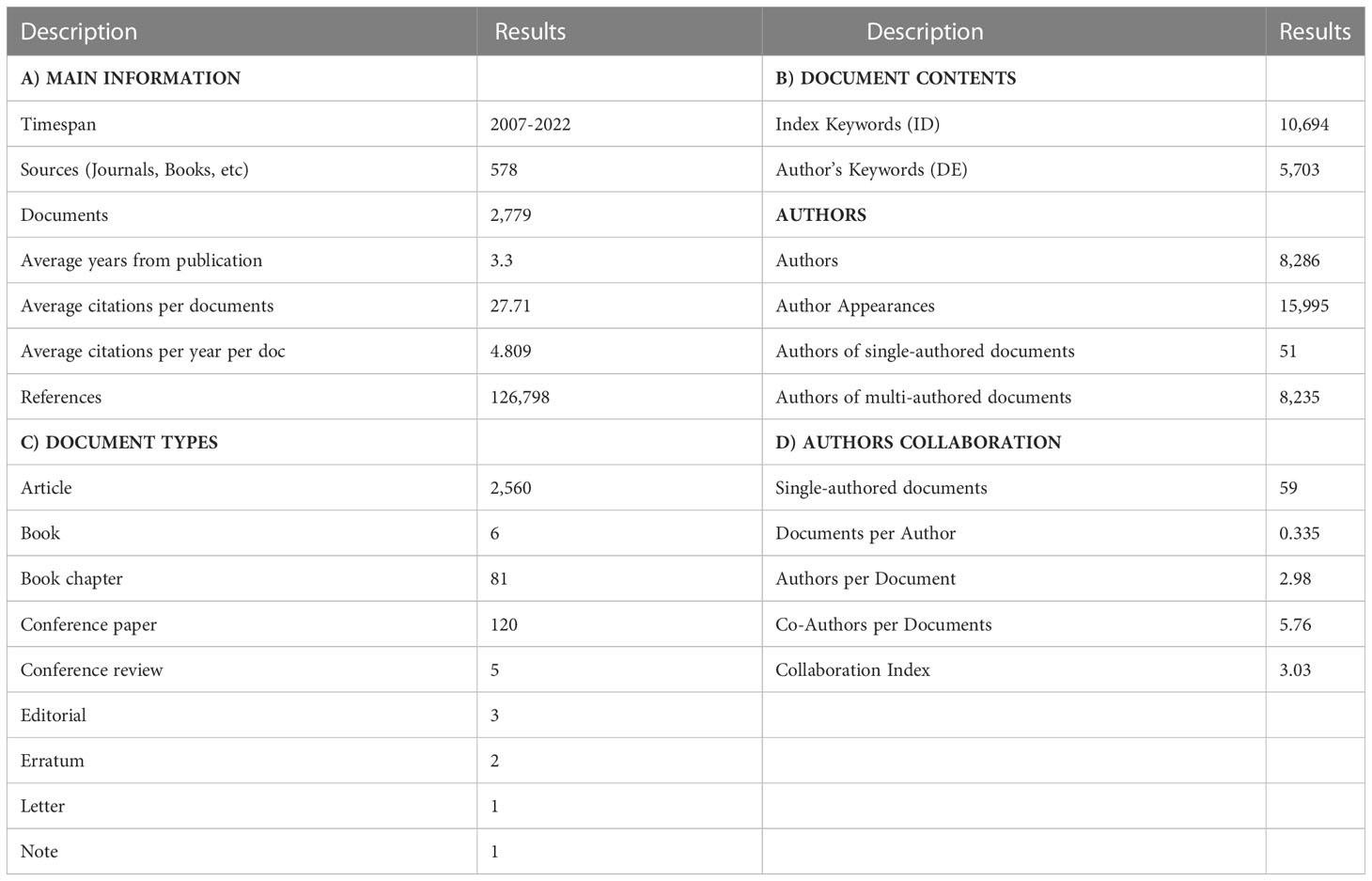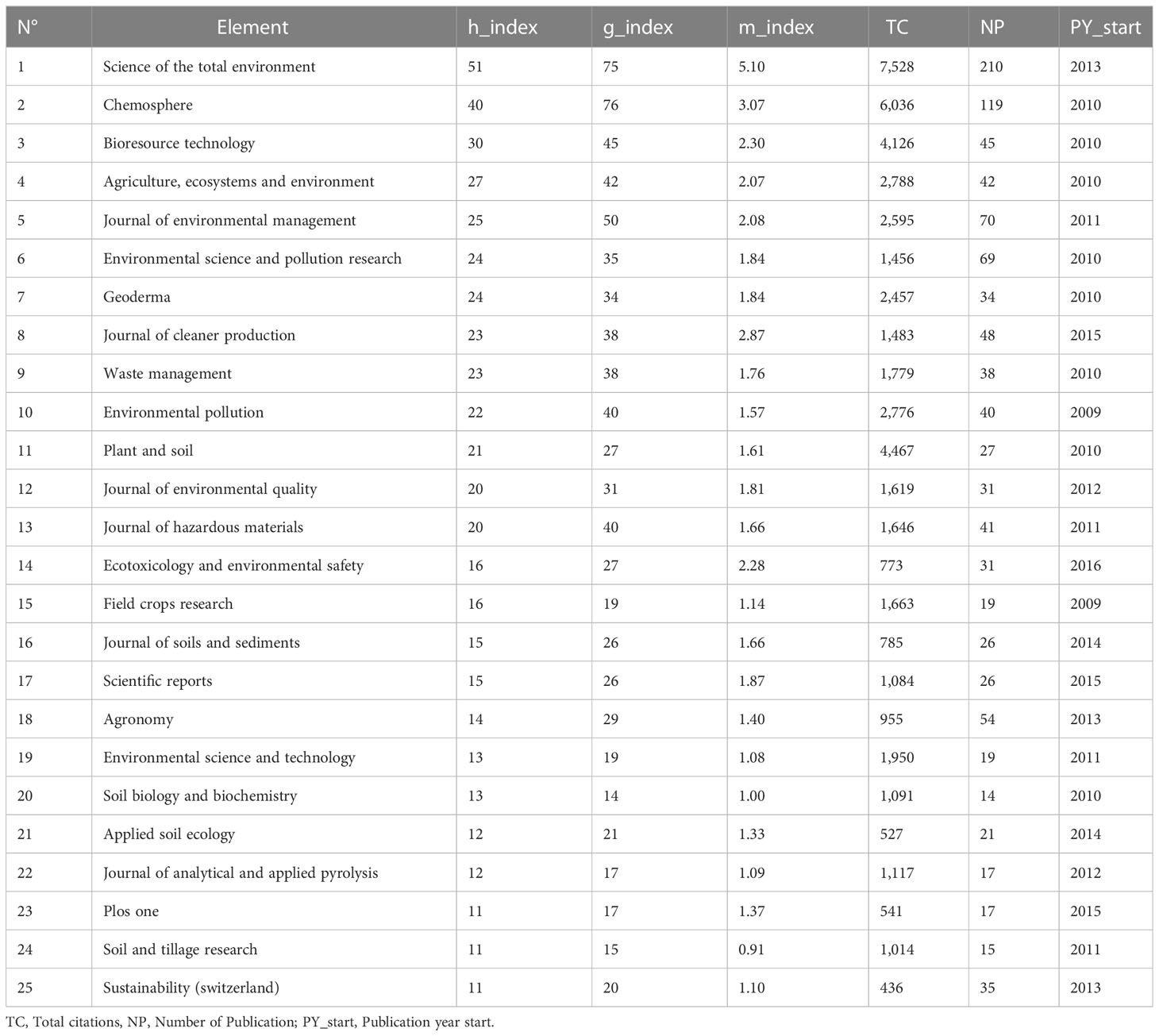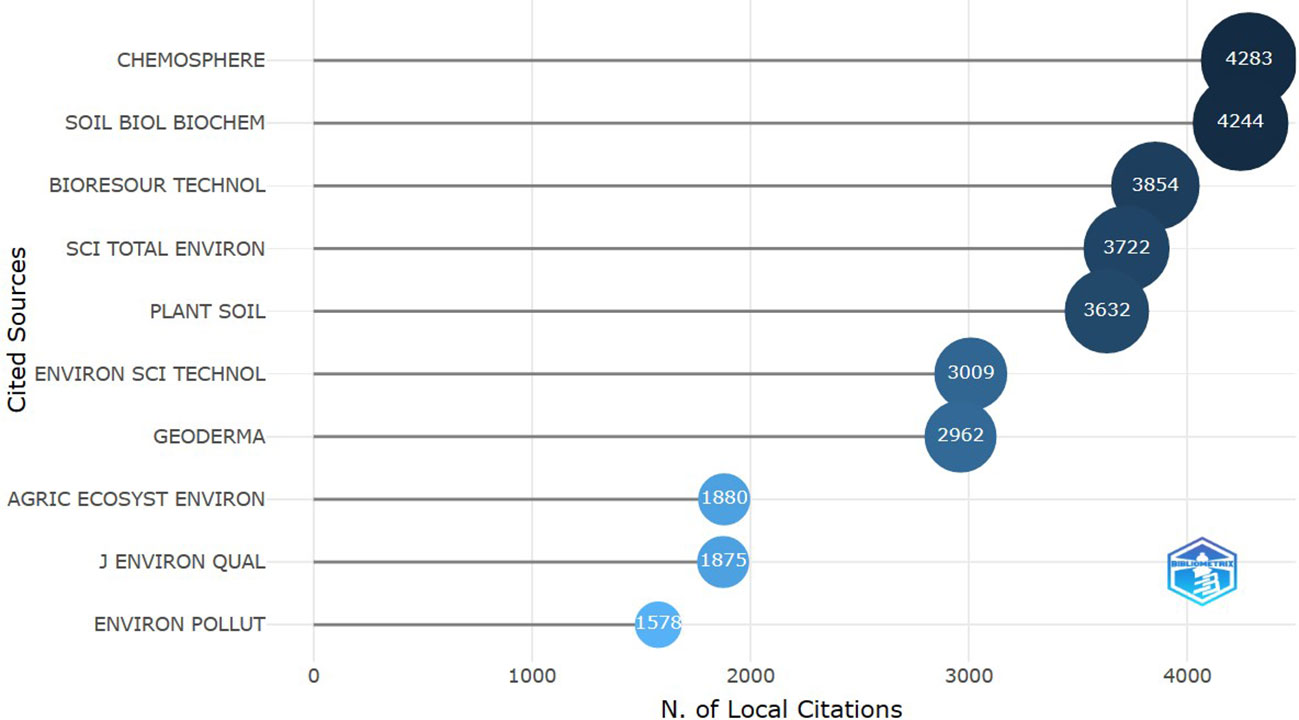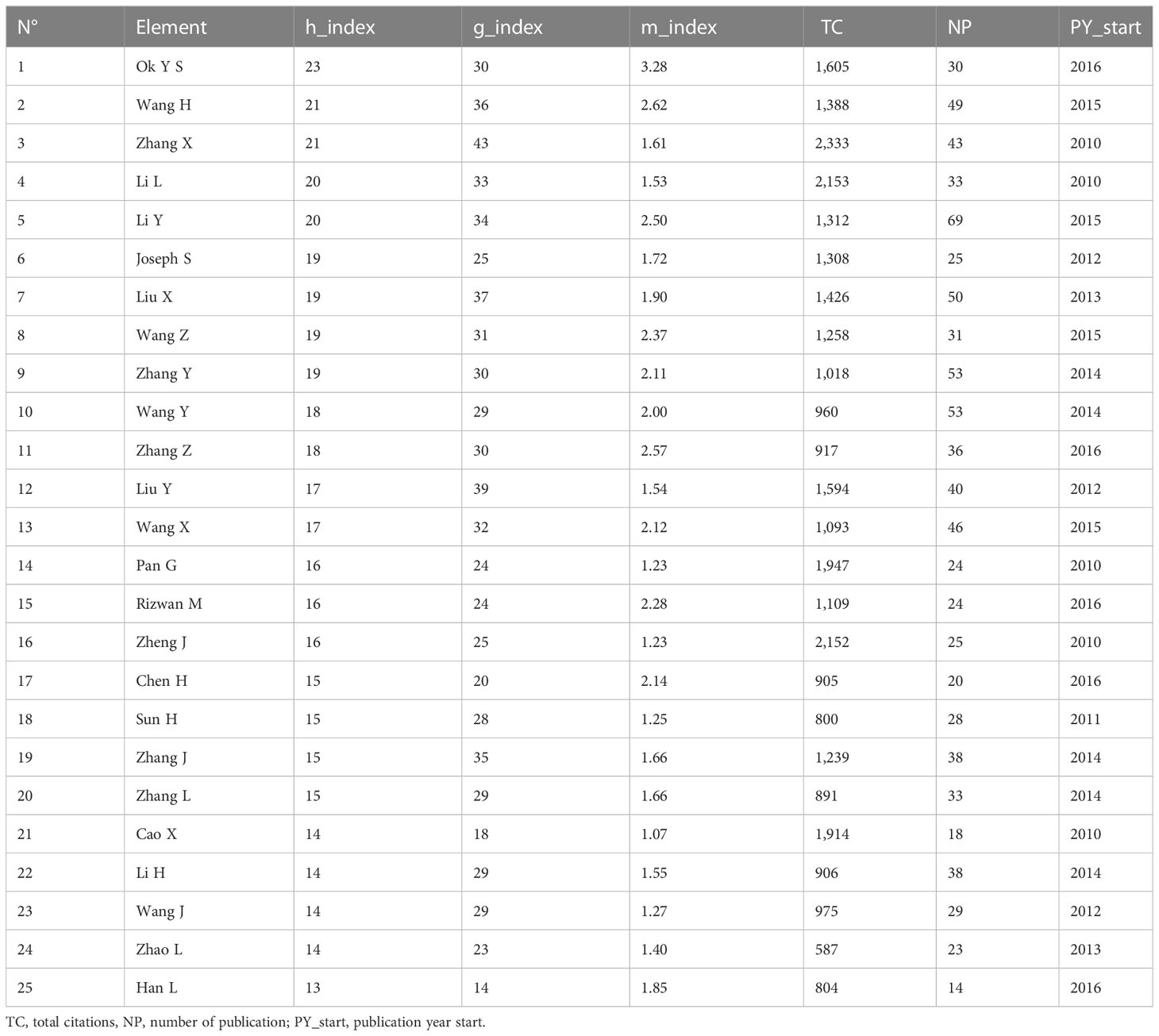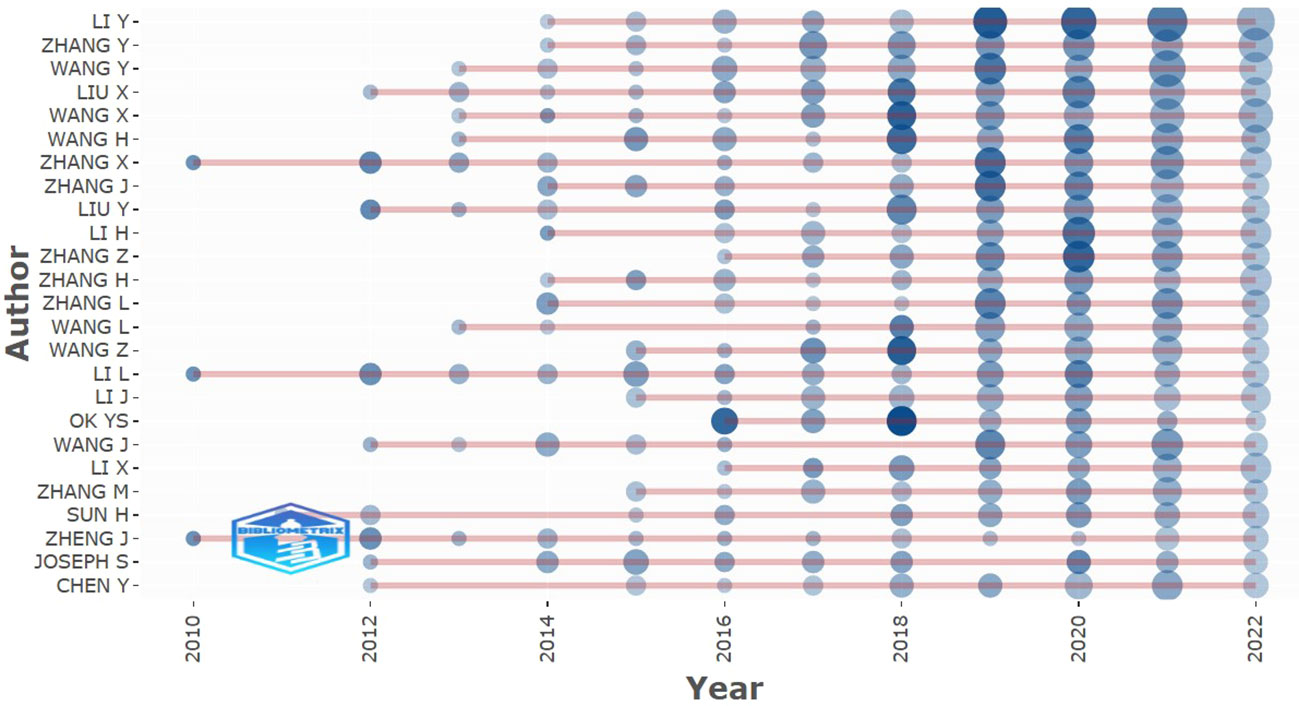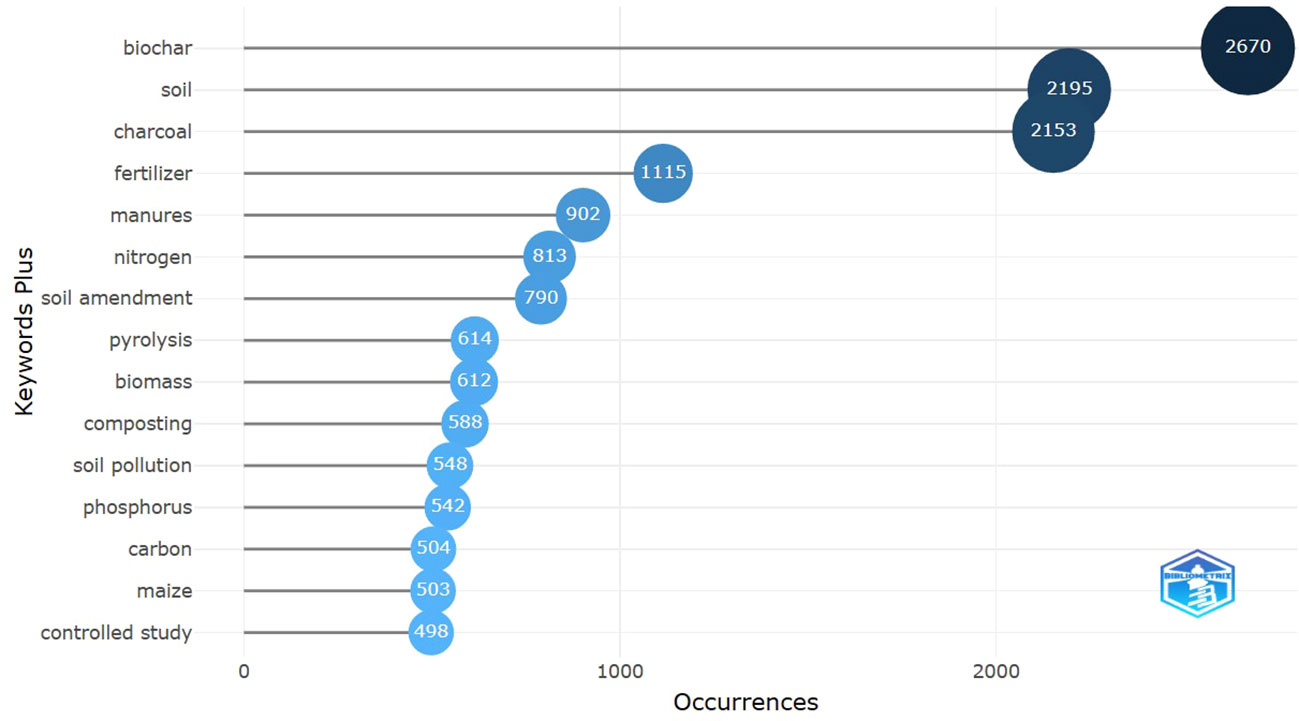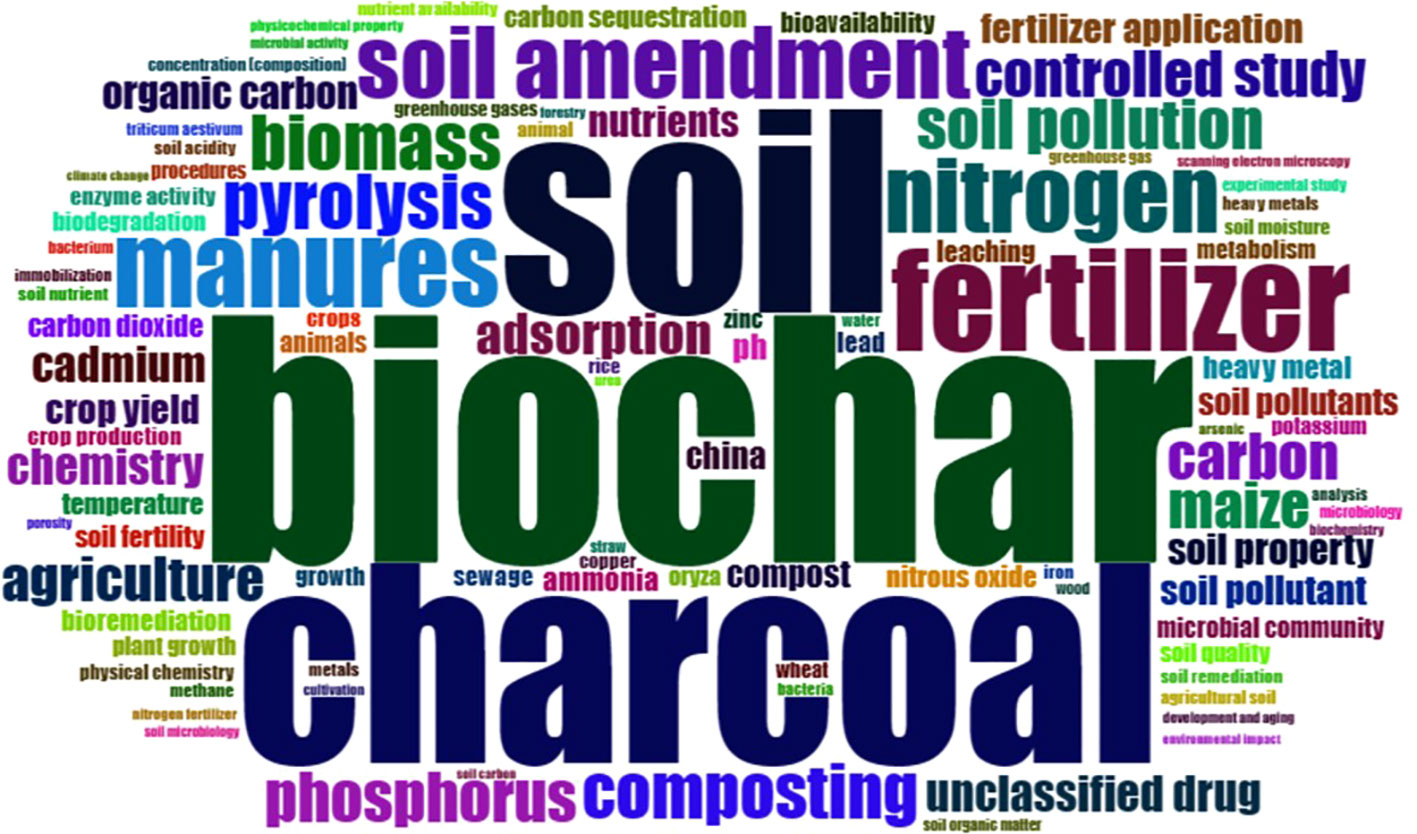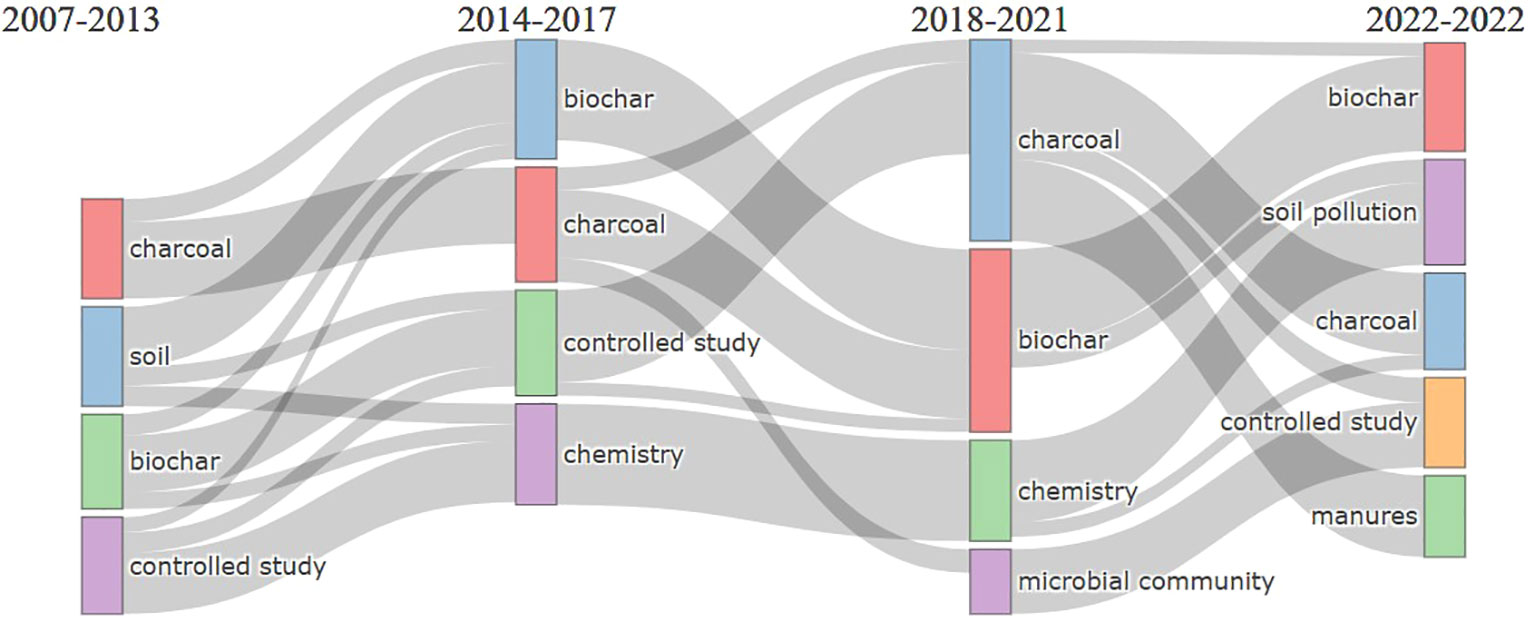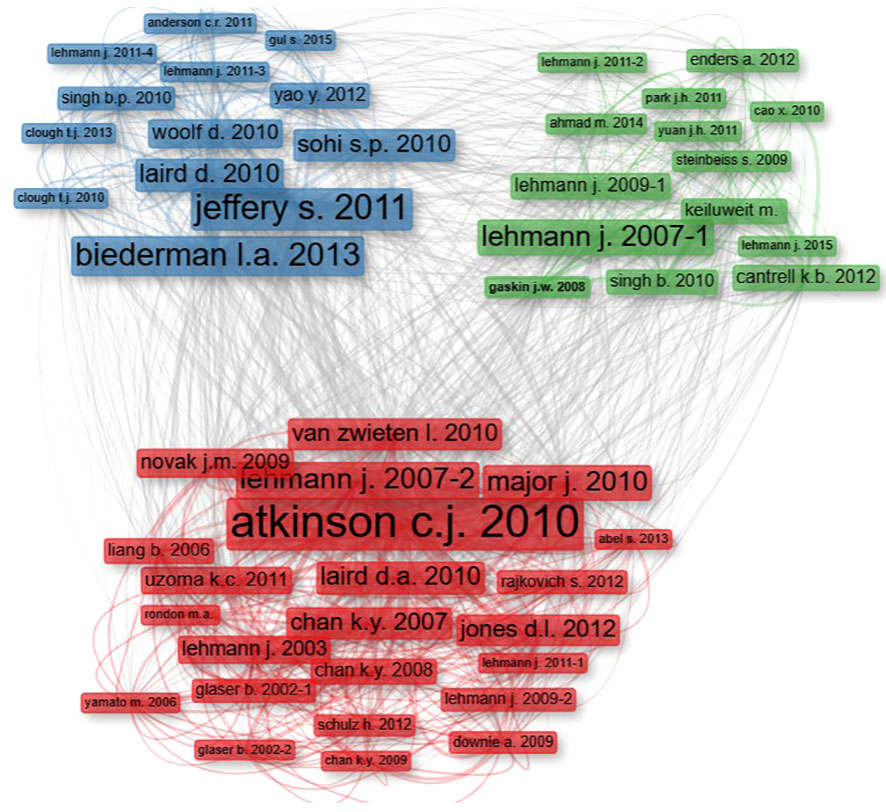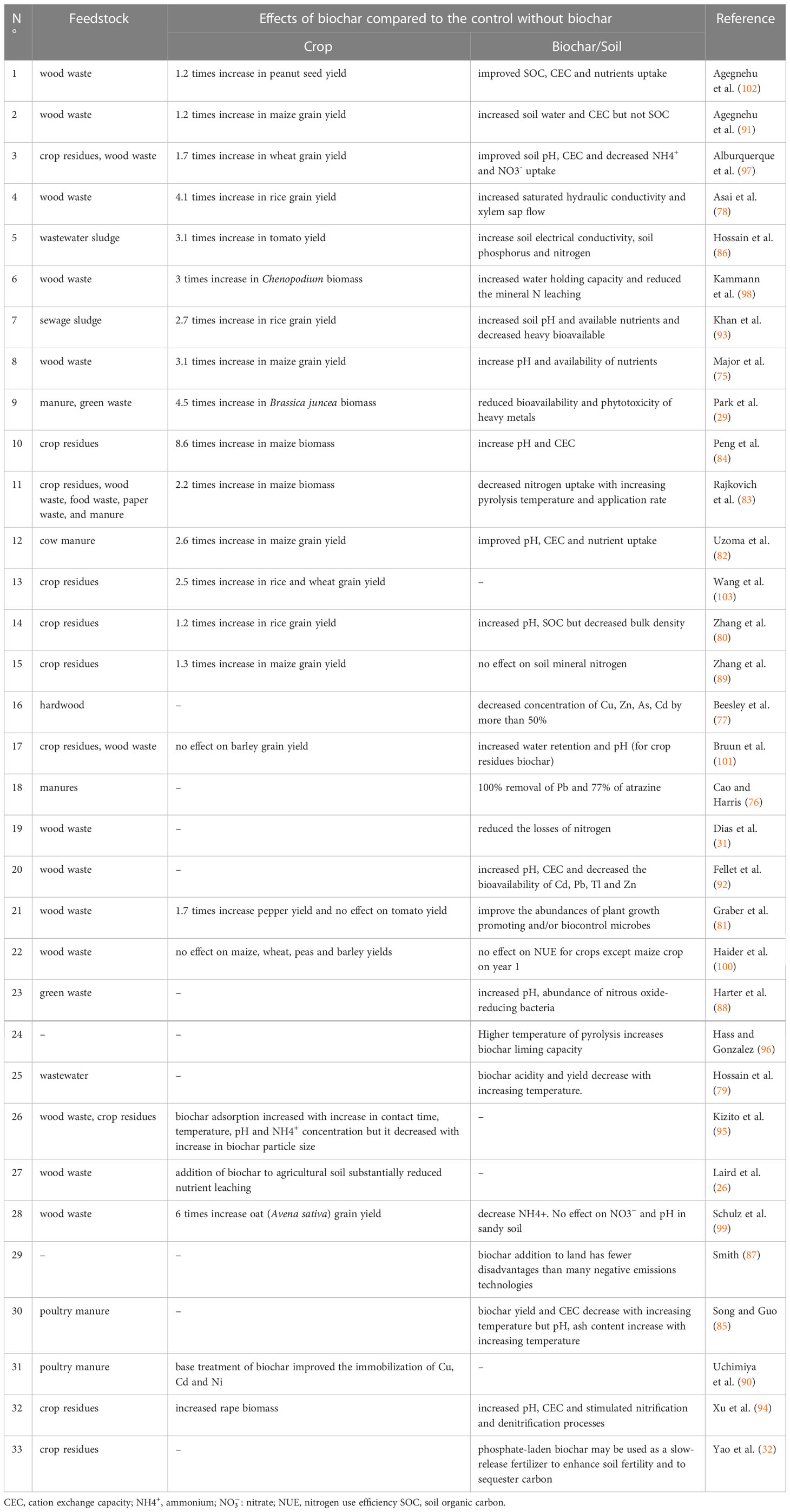- 1University of Parakou, Faculty of Agronomy (UP/FA), Integrated Production Systems Innovation Lab and Sustainable Land Management (InSPIREs-SLM), Parakou, Benin
- 2Soil Protection and Rehabilitation Project to Improve Food Security (ProSOL-GIZ), The Deutsche Gesellschaft für Internationale Zusammenarbeit (GIZ) GmbH, Cotonou, Benin
- 3Faculty of Agronomy, Department of Sciences and Techniques of Plant Production, University of Parakou, Parakou, Benin
- 4Faculty of Agronomy (UP/FA), Laboratory of Hydraulics and Environmental Modeling (HydroModE-Lab), University of Parakou, Parakou, Benin
Several studies have investigated nutrient-enriched and nutrient poor biochar to improve soil properties, increase nutrient use efficiency and crop productivity. Review articles have presented formulations and production methods of biochar-based fertilizers. They reported nutrient-enriched biochar improves -45ves crop productivity, soil health and preserves the environment. But so far, none of the studies has conceptualized the nutrient-enriched biochar as a biochar-based smart fertilizer or presented the conceptual and intellectual structures and the collaborative networks of authors and countries working on biochar-based smart fertilizers. For the first time, this study has mapped the scientific knowledge generated on the topic and established a solid ground for its innovative progress and research pursuits. A total of 2,779 scientific publications on biochar-based fertilizers were exported from scopus database in August 2022 and were analyzed using bibliometrix software package and the biblioshiny web interface in R version 4.1.3. The results indicated that the papers in our collection cover the period from 2007 to 2022 with a raising number from 2017 to 2021. Almost all documents (99.38%) were co-authored with an average of 6 authors (5.76) per article. The analysis of keywords and the evolution of topics revealed that biochar-based smart fertilizers in relation to organic nutrient sources, soil microbiology and soil sanitation were the most studied topics in the scientific debates. China had more collaboration in the network working on biochar-based fertilizers, while the West African countries belonging to the network have not developed any collaboration so far. This suggests the formulation of research projects that may involve African countries to work with other countries including China, USA, Germany, Australia and Poland. This study is more comprehensive in terms of a global view of the conceptual and intellectual contours and network of actors on biochar-based smart fertilizers. Future research on the topic should be conducted more in the fields under farmers’ conditions and may focus on (i) enrichment of biochar with nutrients from organic sources before its application to the soil, (ii) soil remediation and microbiology in relation to biochar-based fertilizer applications, and (iii) economic profitability of biochar fertilizers for small-scale farmers.
1 Introduction
Efficient use of fertilizers is a key pillar for improving agricultural productivity and ensuring food security (1). Synthetic fertilizers are highly soluble and release their nutrients rapidly into the soil. But the nutrient requirements of crops are related to their vegetative stage, which is usually low in the initial stage (2). This most often results in a mismatch between crop nutrient requirements and synthetic fertilizer supply (3). Beig et al. (2) noted that when synthetic fertilizers are supplied to crops, they only use about 40-60% nitrogen (N), 15-20% phosphorus (P), and 50-60% potassium (K). Some of the nutrients not used by the plants are lost to the environment (4).
Nutrient losses represent a financial and energy loss for farmers. They contribute to reduced crop productivity, increased nutrient leaching, water and air pollution (5, 6), and even ecosystem degradation. For example, the surplus of nitrogen is lost as volatilized ammonia that pollutes the air (4), nitrate leaches into groundwater and poses a great risk to human health (7, 8), and nitrous oxide emitted into the air which is one of the main greenhouse gases in agriculture and responsible for global warming (9). Another part contributes with phosphorus to eutrophication of waters resulting in algal blooms and degradation of aquatic ecosystems (10). As for the excess of phosphorus, a part was fixed in the soil by creating a chemical bond with other minerals such as calcium, magnesium, aluminum, iron and zinc making these essential macronutrients and micronutrients unavailable for crop growth (11). The excess of potassium is lost primarily through leaching associated with water movement in the soil and surface runoff (12).
The low efficiency of synthetic fertilizers is therefore an obstacle to sustainable agricultural production (13). Judicious use of mineral fertilizers is essential to preserve the environment, increase food production, and feed the world’s estimated 9.7 billion people by 2050 (14). Then, there is an urgent need to develop a sustainable and environmentally friendly method of delivering nutrients to the soil (2). One of such alternatives is the use of smart fertilizers which through their slow or controlled release mechanism make nutrients available according to crop needs (15, 16). Smart fertilizers are a solution to improve food production while preserving environmental quality (17). They are also referred to as slow- or controlled-release fertilizers (15, 18), ecologically smart fertilizers (15), environmentally friendly fertilizers (19), slow-release ecological fertilizers (20), or improved efficiency fertilizers (21). From a circular economy perspective, Calabi-Floody et al. (17) suggested that smart fertilizers should be based on the innovative recycling and use of crop residues such as biochar.
Biochar is a microporous product, rich in recalcitrant carbon and obtained by thermochemical decomposition of organic matter in an oxygen-limited environment (22). The application of biochar to soils is currently being considered as a way to mitigate climate change by sequestering carbon while improving soil properties and functions (23). Through its dark color, biochar alters soil thermal dynamics and facilitates rapid crop germination (24). Application of biochar (i) promotes crop growth and productivity (25), (ii) improves soil water-holding capacity (26), (iii) reduces crop disease incidence (27, 28), (iv) limits heavy metal bioavailability (29), (v) reduces nitrous oxide emissions from the soil (30), and (vi) reduces nutrient leaching losses (31, 32), which can reduce fertilizer requirements. Studies have developed several biochar-based fertilizers (33) considered as smart fertilizers (16, 34). In this paper, biochar-based fertilizers are referred to as biochar-based smart fertilizers.
Previous studies have synthesized the articles published on biochar-based fertilizers but none of them used the concept of smart fertilizers. Some of them presented the different formulations and methods to produce biochar-based fertilizers and their effect on soil and crops (35–38). Melo et al. (39) reported that biochar-based fertilizers increased crop productivity by 10% over fertilized controls and by 186% over absolute controls. However, this review focused on synthetic fertilizers without including organic fertilizers, which can be used in the manufacture of biochar-based smart fertilizers. In addition to inorganics, biochar-based fertilizers, other works have explored the biochar-based organic fertilizers and their effects on soil as well as crop productivity (40, 41). Wang et al. (42) noted that the combination of organic fertilizer including compost with biochar can increase crop productivity by 48% compared to fertilized controls. In Benin, maize yield was improved by 55% with biochar-based organic fertilizer over the control in various agroecological zones (43). So far, none of the reviews published explored the conceptual and intellectual structures of the knowledge generated from biochar-based smart fertilizers (e.g., authors, countries, institutions, topics). Understanding this structure is fundamental to (i) explain the paradigms that have guided/influenced research on biochar-based smart fertilizers as well as their evolution, (ii) appreciate the productivity and impact of authors that worked on the topic (44), and (iii) map the scientific knowledge generated in order to establish a solid foundation for advancing knowledge on biochar-based smart fertilizers (45). Bibliometric analysis is an appropriate research method to provide a comprehensive overview and classification of research, as well as to further develop emerging areas of research (46). Based on citation mapping, bibliometric analysis can quantitatively synthesize a research topic and provide an overview of the main research directions (47). This bibliometric review aims to (1) address the state of the arts of biochar-based smart fertilizers, (2) identify knowledge gaps, (3) describe emerging ideas and open new avenue for biochar-based nutrient cycling in circular economy and to find practical solutions to high prices mineral fertilizer in the context of war between Ukraine and Russia. Bibliometric analysis is a well-accepted and used scientific method which combines mathematical and statistical techniques to evaluate research (48).
2 Methods
2.1 Data collection
2.1.1 Criteria for the selection of publications
For this bibliometric review, selection of scientific publications was made by predefining our population, intervention and outcome (PIO) according to the PIO protocol, a modification of the Population, Intervention, Comparator and Outcome (PICO) protocol, which is a search tool for reviews (49, 50). The components of the PIO protocol allow to set the criteria for including or not including an article in the review and to formulate the search equation for data collection (51). Thus, our population was crop production studies; the intervention was biochar-based smart fertilizer application (with organic or mineral) and the outcomes were crop yield or crop productivity, soil properties, and environmental quality. The keywords and search equation were formulated from these three components of the PIO model. To ensure that the papers selected were articles, we added a filter to exclude review articles.
2.1.2 Data collection strategy
We searched for titles of publications, abstract and keywords of the Scopus database. Scopus is one of the largest and most comprehensive databases providing access to documents with a large number of references and citations (52) on several disciplines including agriculture and environment. We used the following search equation: (TITLE-ABS-KEY (biochar) AND TITLE-ABS-KEY (compost* OR co-compost* OR fertili?er OR “nutrient” OR “Biochar-based fertili?er” OR “slow release” OR “controlled release” OR “smart fertili?er”) AND TITLE-ABS-KEY (“crop yield” OR “crop productivit*” OR “Soil propert*” OR environment*) AND NOT TITLE-ABS-KEY (review OR “quantitative review” OR synthesis OR bibliometric OR scientometric OR “Systematic map” OR “meta-analysis” OR “State of the art” OR “Current topics in” OR “Progress in” OR “Advances in” OR “Critical survey” OR “Comprehensive survey”) AND (EXCLUDE (DOCTYPE, “re”)). The search for publications was performed on 14.08.2022 and was not updated during this work. A total of 2779 scientific publications were identified, covering the period from 2007 to 2022. The metadata exported per publication were:
● Citation information (authors, document title, year, source title, volume, issue, page, number of citations, source and document title, publication stage, DOI)
● Bibliographic information (affiliations, series identifiers, publishers, source short title)
● Abstract and keywords (abstract, author’s keywords, index keywords)
● Funding details (sponsor, funding text)
● Other information (Include references)
To override the 2,000 publications upload limit in Scopus, the files were uploaded in two batches, from 2007 to 2019 and from 2020 to 2022, so that each batch did not exceed the 2,000 publications. The publications were exported in BibTeX and RIS formats to form our collection for further processing and analysis.
2.2 Data analysis
The metadata collected were analyzed to extract potential knowledge from the scientific literature. The results were visualized using the Bibliometrix package (53) of R version 4.1.3 and its biblioshiny web interface. R software runs in an integrated environment and consists of open libraries, open algorithms, and open graphics software (54). Bibliometrix, one of the R packages, is highly suitable for bibliometric analyses of Scopus data (55, 56). The integrated functions of bibliometrix were used. They are:
o “combine” to fuse the publications in our collection into one database;
o “ convert2df “ to convert the files into a data table;
o “ mergeDbSources “ with the option “ remove.duplicated “ to remove the possible duplicates;
o “ saveRDS “ to save the bibliographic data table in “ rds “ format for import and use in biblioshiny.
The metadata were analyzed to extract potential knowledge contained in the scientific literature.
To understand the intellectual structure of knowledge on biochar fertilizers, it is necessary to conduct a document analysis to identify the quantity and authority of the literature cited. In addition, to better understand the research trend on biochar smart fertilizers, the keywords in the index were analyzed. To avoid duplicates, the same ones with different spellings of words separated by dashes or written in capital letters were grouped together. For example, “maize and Zea mays” or “manure and manures” or “biochar, biochars and bio-char”. Also, words such as “article” or “na” were removed as they do not provide any information about the content.
Bibliometric linkage was performed to analyze the documents, authors and nature of the scientific debates on biochar-based smart fertilizers. When at least one cited source appears in the bibliographic references of two papers, the two papers are said to be bibliographically coupled (53).
Thematic evolution shows the changes of keywords over time. It helps to analyze and identify the most relevant research themes and also provides insight into the future direction (57). It also helps to identify the most recent issues related to the topic being studied (58). According to Velasco-Muñoz et al. (59), thematic evolution is a major strategy for providing a historical perspective of research and providing a scientific model focused on future research directions.
Two articles are co-cited when both are cited together in a third article. The co-citation analysis establishes the relationship between articles based on the frequency with which they are co-cited together (60). Referenced citations were set to a minimum of 5 times and 50 articles from our collection were considered (61). Each node indicates a reference and the size illustrates the normalized number of citations received by the articles.
A collaboration network indicates how authors or countries come together to work in a particular field (62). A minimum threshold of 50 authors was set and the size of the ellipse indicates the number of publications by an author or country. The intensity of collaboration is measured by the thickness of the line and the spacing of the circles. The number of papers published by authors representing two or more countries determines the total strength of a country’s relationship.
A brief narrative synthesis was added to the bibliometric review to highlight the role of biochar in agriculture, particularly its effects on soil and crops. The narrative synthesis was based on the most cited documents locally (n=25) and globally (N=25). Of these 50 most cited documents, 17 documents were found to be common between the most cited locally and globally. A total of 33 most cited documents were mined for the narrative synthesis section. As studies on biochar have been carried out in several countries and under different experimental conditions, it is essential to establish a baseline to facilitate comparison between the different papers. Therefore, for each study and depending on the availability of data, the magnitude of the effect of biochar on crops was calculated by dividing the value of the biochar treatments by the value of the control treatment.
3 Results and discussion
3.1 Main information about the collection
In this study, the available knowledge on biochar-based smart fertilizers for sustainable agricultural production was mapped (Table 1). A total of 2,779 articles were published within the period 2007 to 2022 (15 years). These documents contain 126,798 references and each document is cited 27.71 times on average. This showing that they documents are well appreciated in scientific works. The keywords, automatically generated by an algorithm from the references citation in the documents are almost double of the authors’ keywords (10694 out of 5703) confirming that they are more informative than the authors’ keywords (63, 64). The total number of authors is 8,286 of which 8,235 are authors of the multi-author documents. Almost all the documents (99.38%) collected are co-authored with about 6 authors (5.8) per document. The index of collaboration between authors is 3.0. This low index indicates that the authors worked in research groups and there is low collaboration between the research groups.
3.2 Trends in publication and citation
Figure 1 shows the number of papers published per year, as well as the average number of total citations per paper per year during the study period. The number of publications on biochar-based smart fertilizers has increased overall from 2007 to 2022. The evolution of publications on biochar-based smart fertilizers can be divided into three periods. The first period covers 2007 to 2013 with a total of 166 publications and an annual average of 23.71 publications. The second period is from 2014 to 2017 with a total of 603 publications and an annual average of 150.75 publications and the third period is from 2018 to August 2022 with a total of 2,010 publications and an annual average of 402 publications. This last period is the most prolific in publications. The exponential increase in publications in the last period can be explained by two major events in 2017. These were the Climate Chance Summit held in September 2017 in Agadir with its flagship declaration “Intensifying Action and Ambition Together” and the international summit to combat global warming held in December 2017. These two summits have undoubtedly contributed to intensifying studies on the potential of biochar-based smart fertilizers to (i) sequester carbon in the soil and thus decrease the emission of carbon dioxide, CO2; (ii) reduce nitrous oxide (NO2) emissions due to the ability of these fertilizers to increase nutrient use efficiency and (iii) reduce methane emissions from livestock systems through the valorization of manure and sewage sludge into nutrient rich biochar. The first paper on this topic was published by Dover (65) and focused on the potential of biochar for soil management and carbon dioxide emission reduction.
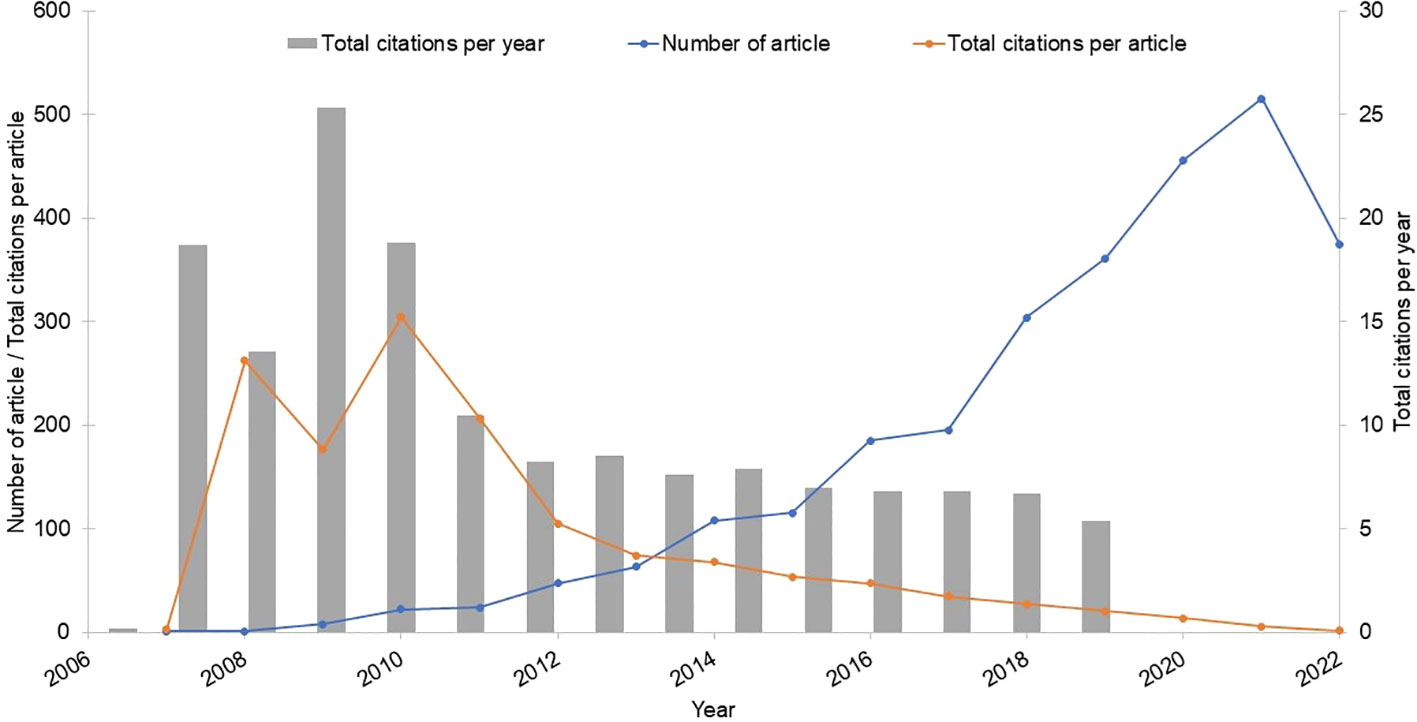
Figure 1 Worldwide publication and citation history on biochar-based smart fertilizers from 2007 to 2022.
The total citations per article climbed from 2007 to 2010 with a slight drop in 2009. Between 2011 and 2012, it dropped drastically before gradually decreasing from 2013 to August 2022. The great food crisis in 2007 and 2008 put the fight against hunger back on the international agenda and a World Summit on Food Security was organized by the FAO from 16 to 18 November 2009 (66). Thus, this has favored the citations of scientific research on biochar-based smart fertilizers between 2007 and 2010 in the perspective of finding solutions to increase agricultural production. On the other hand, the decrease observed from 2011 to August 2022 can be explained by the fact that similar publications have grown considerably in recent years or that a few articles have contributed considerably to this volume of information. This indicates that biochar-based smart fertilizers developed rapidly in the beginning but slowed down later due to low novelty in the subsequent research work (61). The most cited paper during the 15-year study period was from (67) entitled “Reversibility of soil productivity decline with organic matter of differing quality along a degradation gradient”. This article alone had 262 citations. This shows that it is a pioneer article and has strongly influenced the development of biochar-based smart fertilizers. The highest value of average total citations per article was 304.2 and it was observed in 2010 with 22 articles. The highest total citations were found in 2010 (25.3), 2011 (18.8) and 2008 (18.7).
3.3 Source impact
The most influential sources on biochar-based smart fertilizers were reported here. The papers in the collection were published in 482 sources. Table 2 illustrates the 25 most influential sources based on five indicators (H-index, G-index, M-index, total citations, and number of publications). All three (indexes) are discussed in the literature (68–70). Among the 25 most influential sources, eight started publications in 2010. According to the collection in this study, the number of publication sources increased from 1 in 2007 to 23 in 2010. Hence, the sources that started publishing in 2010 have more influenced the development of biochar-based smart fertilizers. As a reminder, 2010 is a year following the severe food crisis and oil price hikes (66). Figure 2 shows the top ten most cited sources in the collection. The source of the chemosphere journal was locally most cited (4,283) followed by the soil biology and biochemistry (4,244); while environmental pollution was the tenth with 1,578 local citations.
3.4 Most impactful authors
The analysis of the authors’ performance is necessary to evaluate their contribution to the evolution of the theme studied. Several indicators are used to assess the performance of authors. The most important indicators are the number of publications, total citation, H-index, G-index and M-index. The last three indicators (G-, H- and M-indexes) combine both the number of citations and publications to assess the performance of authors. The top 5 authors in the list are Ok Yong Sik, Wang H, Zhang X, Li L and Li Y (Table 3). On this list, the 5th author, (Li Y) published 69 papers while the 1st author (Ok Y S) published 30. The 3rd author (Zhang X) had 2,333 total citations while the 2nd author (Wang H) had 1,388. Figure 3 completes these observations by displaying the scientific production of the authors through the number of papers per year. Per author, the line indicates the chronology of author’s publications, the size of the bubble is proportional to the number of papers and the intensity of the color is related to the number of citations per year. Although it is accepted that the number of publications is a proxy for the author’s productivity and the total number of citations is a proxy for the author’s impact (45), in this study neither the total number of citations nor the number of publications can satisfactorily rank the authors. Su et al. (71), reported that the number of publications does not represent highly cited articles because there were several factors that influence the citation of an article. For example, the accessibility of the article (free or paid); the language of publication.
The use of indicators that combine citation and number of publications to evaluate the performance of authors is necessary. H-index is calculated on the principle that h articles are cited at least h times (68). G-index is determined on the principle that an academic has published at least g articles that, combined, have received at least the square of g (69). M-index divides H-index by the number of years during a scientist has been active (70). This shows that G-index and M-index are variants of H-index. The prioritization of the top 25 authors list is focused on G-index. The rationale for this choice is that it is an indicator for assessing the quality of scientific output (72). It also accurately indicates the author’s scientific contribution and success (73). However, H-index is not suitable for comparing interdisciplinary fields (74).
3.5 Most impactful documents
Table 4 shows the top 25 cited documents on biochar-based smart fertilizers. These papers were ranked in descending order of global citations (GC) received (Table 4A) or local citations received (Table 4B). According to (61), global citations (GC) represent the number of total citations that an article in a collection has received from indexed documents on a bibliographic database (Dimensions, Scopus, WoS, Lens, etc…). Thus, the global citations take into account the citations received by a document throughout the scientific world. The same authors defined local citations as the number of times that an author (or a document) included in a collection has been cited by other documents in the same collection. Thus, the term local is related to the sphere of the collection, i.e. the set of documents exported from a bibliographic database as part of a study. In the top 25 cited papers on biochar-based smart fertilizers, the overall citations range from 330 to 870 (Table 4A). The three authors with more global citations are Major et al. (75); Cao and Harris (76) and Beesley et al. (77) with 870, 841 and 840 global citations respectively. As for the local citations, they ranged from 54 to 219 (Table 4B). The three authors with more global citations were Laird et al. (26)Hass and Gonzalez (96) and Major et al. (75) with 219, 208 and 198 local citations, respectively. Regardless of citation type, Major et al. (75) is among the 3 papers on biochar-based smart fertilizers. This paper investigated the medium-term (4 years) effect of different biochar rates (0, 8 and 20 t/ha) on maize nutrition and yield in a maize-soybean rotation. He found a 140% increase in maize yield and an increase in soil pH. He attributed the increase in maize yield to improved nutrient uptake. Thus, an efficiency of use of available nutrients in the soil. Furthermore, we found that regardless of the type of citation, among the top 6 papers 5 were published in 2010, in the aftermath of the global food crisis as discussed in section 3.2.
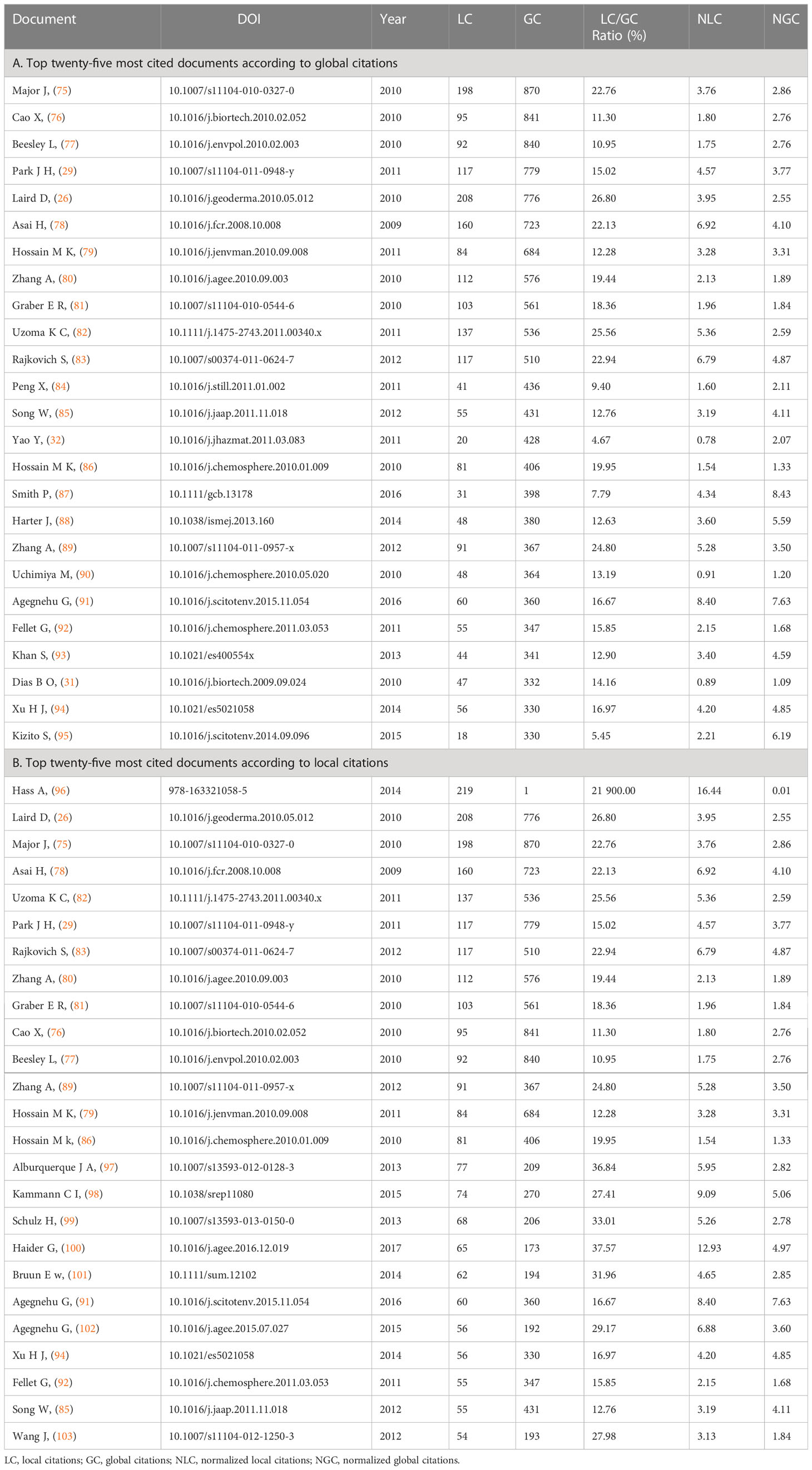
Table 4 Top twenty-five most cited documents on biochar-based smart fertilizers according to global citations (A) and local citations (B).
3.6 Keywords’ analysis
Figure 4 illustrates the top fifteen most used keywords on the theme. The occurrence of the words is their frequency of appearance. Thus, keywords such as biochar (2,670), soil (2,195), charcoal (2,153), fertilizer (1,115) and manures (902) were mostly used. The words “biochar” and “charcoal” were not treated as synonyms because biochar is produced through pyrolysis in the absence of oxygen while charcoal is produced through carbonization (22). For example, several studies have explored the potential use of hydrochar in agriculture (104, 105). Hydrochar and biochar show different physicochemical properties that significantly affect their potential application (106). The use of the words “fertilizer” and “manures” alongside biochar and charcoal indicates that smart fertilizers based on biochar or charcoal are made from both synthetic mineral fertilizers and organic fertilizers and are applied to the soil to feed crops. However, it should be noted that less research has been done on combining biochar with nutrients from organic sources (manure) than on combining biochar with nutrients from synthetic fertilizers. On the top 15 keywords, there were two macronutrients namely nitrogen (813) and phosphorus (542) that often appeared. We can deduce that the works related to smart fertilizers based on biochar have more explored the (efficient) use of these two macronutrients by the crops, especially nitrogen. One of the main crops that has received more attention from the studies was maize with 503 occurrences. The effect of biochar-based smart fertilizers on soil pollution (548) was also discussed in the literature. The appearance of controlled study (498) among the 15 most frequent keywords indicates that there are more researches in controlled environments on this topic. As a complement to Figures 4, 5 presents the word cloud (minimum 100 keywords). The thickness of a word illustrates its frequency. The thicker words are the most used and the thinner words are less frequent.
3.7 Bibliometric coupling of documents
Figure 6 shows a scientific mapping that reveals the most essential papers (impact, horizontal axis) and how they are related (centrality, vertical axis). The unit of analysis was documents. The top 300 documents were selected from our collection of 2,779 with a minimum of 10% clustered linkage frequency measured with references. The impact of the document was measured by the number of local citations. Thus, four clusters were found according to the centrality and impact of the topic of each cluster represented in different colors (cluster purple: 1; cluster blue: 2; cluster green: 3; cluster red: 4). The size of the node of each cluster is proportionate to the number of documents that form it.
The red cluster (1) was characterized by a centrality of 0.347; an impact of 3.005 and 69 documents. It is located in the upper right quadrant. So, the documents in cluster 1 are more essential and more related to biochar-based smart fertilizers. The paper by Hass and Gonzalez (96) contributed more to the topic of this cluster with 8.12 normalized local citations. It was followed by Haider et al (5), with 7.11 normalized local citations and Ibrahim (107) with 6.65 of normalized local citations. These 3 main papers focused on the ability of biochar to retain nutrients and reduce their leaching.
The blue cluster (2) was characterized by a centrality of 0.337; an impact of 2.417 and 91 documents. It is placed in the lower right quadrant. Thus, the documents in cluster 2 are central but less related to our theme. The preponderant papers in this cluster were those of Agegnehu (108), with 5.86 normalized local citations, followed by Agegnehu et al., (102), with 5.86 normalized local citations as well as Arif (109), with 5.43 normalized local citations.
The green cluster (3) had a centrality of 0.335 with an impact of 2.728 and 62 papers including Domingues (110), Adekiya (111) and Akhtar (112). The normalized local citations of these top 3 papers were 12.28; 10.6 and 5.55 respectively. This cluster is located in the lower left quadrant. These papers are therefore less essential and less related to our topic on biochar-based smart fertilizers. However, they may include the emerging terms useful to our topic (58, 62).
The red cluster (4) had a centrality of 0.308; an impact of 2.952 and 78 papers including Oladele (113) with 16.27 normalized local citations followed by Cooper (114) with 6.99 normalized local citations and Trupiano (115) with 4.27 normalized local citations. It is placed in the top left quadrant. These papers are related to the topic under study but are less essential (low impact).
3.8 Conceptual structure and research underpinnings
Figure 7 presents the evolution of the 250 most used words in the literature on biochar-based smart fertilizers following the co-occurrence network. Based, on the evolution of publications, three years were set as cut-off points. These are 2013, 2017 and 2021. The size of the bars indicates the frequency with which the keywords appeared and the color helps to distinguish the keywords. From 2007 to 2013, the most commonly used keywords in search engines for biochar-based smart fertilizers were “charcoal,” “soil,” “biochar,” and “controlled study.” From 2014 to 2017, the word “soil” disappeared and “chemistry” was the new word appearing in the literature. “Chemistry” is related to three words from the earlier period, namely “controlled study”, “biochar”, and “soil”. “Chemistry” has a strong association with “controlled study”, as indicated by the width of the band connecting the two words. (Figure 7). This means that during 2014-2017, there were several controlled studies related to “biochar”, “chemistry” and “soil”. But, during 2018-2021, the keyword “charcoal” was used in most studies and was merged into “biochar” in the next period. “Microbial activity” is a keyword that emerged spontaneously without the contribution of other words. Thus, studies on “biochar” and “soil microbiology” emerged. In August 2022, “manure” and “soil pollution” were two keywords that suddenly appear for the first time in the thematic evolution. The branch of “manure” comes from “charcoal” in the period 2018-2021, and the branch of “soil pollution” comes from “chemistry” and “biochar”. This suggests that since “manure” is an organic source of nutrients, studies are currently being done to utilize it in the production of nutrient-rich charcoal, a variant of biochar-based smart fertilizers. Also, the link between “chemistry” in the previous period and “soil pollution” in August 2022 reflects that research is currently focused on soil pollution by chemicals such as herbicides and heavy metals. The current main research axes are “soil pollution”, “biochar”, “manure”, “charcoal”, and “microbial community”.
3.9 Co-citation network analysis
The co-citation network analysis was performed and is shown in Figure 8. Three clusters were identified and were represented in different colors (cluster red: 1; cluster blue: 2; cluster green: 3). Nodes of the same color are part of the same cluster. Each box was labeled with the first author of the article and the year of publication. The main ideas of these clusters can be considered as the theoretical foundations (61) of all the work that has been done on biochar-based smart fertilizers. Table 5 summarizes the top 5 authors of the three clusters from the co-citation network. The number of articles constituting the clusters has been specified and each cluster is characterized by the parameters betweenness, closeness and PageRank. Betweness presents information about the role played by the authors in a network, while closeness indicates the ability of nodes to efficiently transport information by being closer to other nodes in the network and PageRank is an indicator of the prestige of publications that have influence on the research domain. A publication with a high PageRank is considered to be of high quality and therefore a “must cite” among highly cited publications. For example, in cluster 1, Atkinson (116) is the highest quality publication (PageRank=0.048), followed by Jeffery et al. (23) and Biederman and Harpole (117). The main idea of these authors in cluster 1 is the variation of biochar effect with environment (soil and climate). In cluster 2, the publication with the high quality is with Lehmann (118) (PageRank=0.023) followed by Cantrell (121) and Keiluweit (122). These authors indicated that the physicochemical characteristics of biochar vary depending on the nature of the organic material used and the temperature of pyrolysis. In cluster 3, Lehmann (123) (PageRank=0.025) is the highest quality publication followed by Chan (124) and Lehmann (126). These authors pointed to the role of biochar in improving the nutrient use efficiency of plants and reducing leaching losses. These three main ideas form the theoretical basis for research on biochar-based smart fertilizers. Biochar when enriched with nutrients increases the efficiency of use by plants by reducing leaching losses. However, the effect is variable depending on the soil and climatic conditions of application.
3.10 Network for authors’ collaboration and countries
Figures 9 show the collaborative network of authors (9A) and countries (9B) that have worked on biochar-based smart fertilizers. In the collaboration between authors, 4 clusters emerged (cluster red: 1; cluster blue: 2; cluster green: 3; cluster purple: 4). Wang Y (cluster red), Zhang X (cluster blue), Rizwan M (cluster green), Zhao L (cluster purple) have the highest betweenness per cluster, respectively. These authors are therefore closer to each. They are therefore more collaborative in their cluster. In the authors’ collaboration network, Wang Y (cluster red), Zhang Y (cluster red), Li Y (cluster red), Zhang X (cluster blue) and Liu X (cluster blue) are the five most collaborative authors.
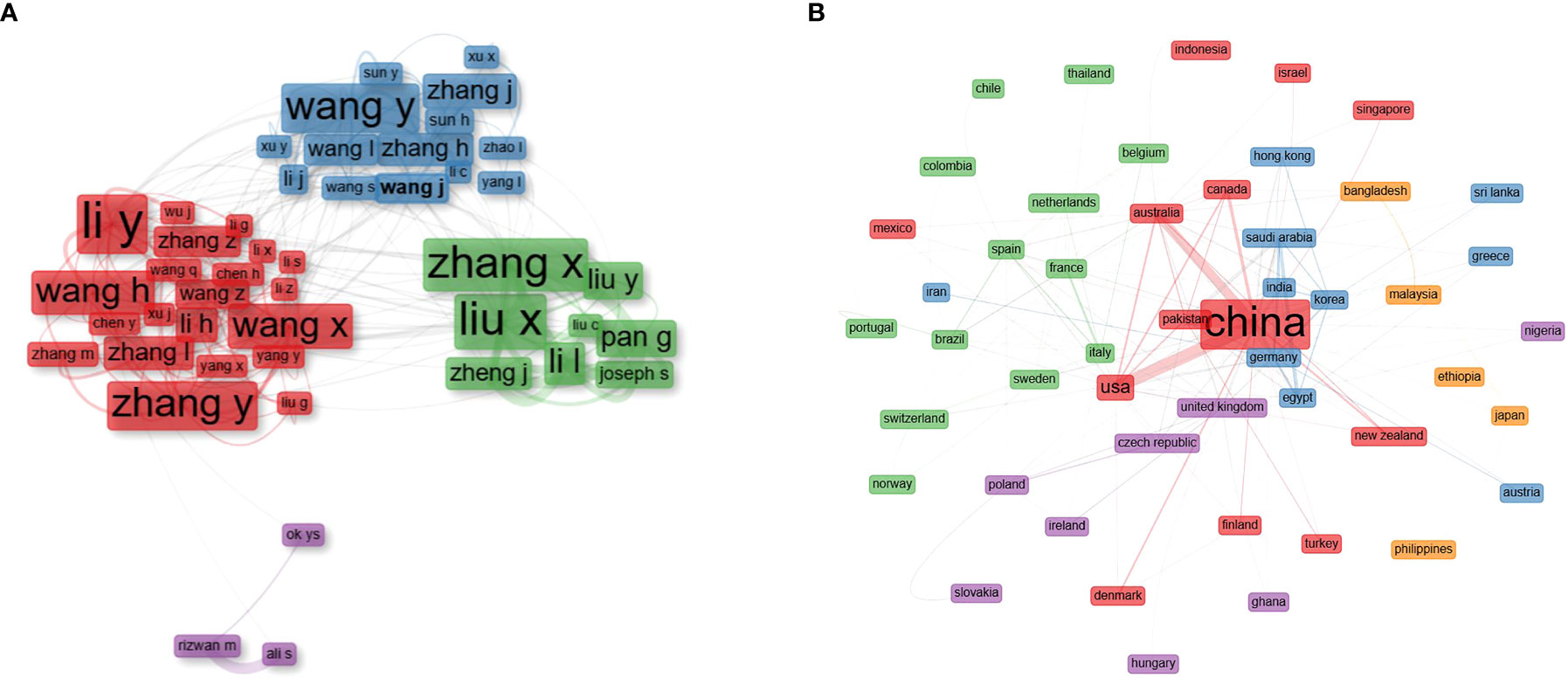
Figure 9 (A) Collaboration network of authors working on biochar-based smart fertilizers. (B) Collaboration network of countries working on biochar-based smart fertilizers.
In the network of collaboration between countries, the five countries with more collaboration are respectively China (betweenness=338.35), USA (betweenness=151.70), Australia (betweenness=133.05), Germany (betweenness=128.31) and Poland (betweenness=48.91). The African countries involved in the network have a low betweenness: Egypt (2.05); Ethiopia (0.19); Ghana (0) and Nigeria (0). This shows little or no collaboration between these countries and the network of researchers on biochar-based smart fertilizers. The 5 top countries with more impact in the collaboration network were China (PageRank=0.151); USA (PageRank=0.072); Australia (PageRank=0.067); Germany (PageRank=0.630) and Pakistan (PageRank=0.058).
3.11 Impacts of biochar on crops and soils
Biochar is produced from a variety of feedstocks. These include crop residues, wood waste, food waste, paper waste, sewage sludge, wastewater sludge, green waste, and manure (Table 6). The yield and physicochemical properties of biochar depend on the pyrolysis temperature (127). The cation exchange capacity (CEC) and organic carbon (OC) content of biochar decreased with increasing pyrolysis temperature, while, the pH, ash content, and specific surface area of biochar increased with increasing pyrolysis temperature (85). However, beyond the pyrolysis temperature, Rajkovich et al. (83) reported that the type of feedstock used to produce biochar has a great effect on crop response to biochar application.
Biochar is applied alone or in combination with nutrient sources. It is used as a greenhouse gas negative technology and has fewer drawbacks (87). The most commonly used nutrient source to enrich biochar is mineral fertilizers (75, 78, 81–84, 86, 88, 93, 97, 100, 101). However, a few papers have investigated the enrichment of biochar with nutrients from organic sources such as compost (77, 98, 99) and manure (26, 31, 95). Moreso, Agegnehu et al. (102); Agegnehu et al. (91) used both mineral fertilizer and compost to enrich biochar with nutrients before application to soil.
Biochar exhibits several effects on both crops and soils (Table 6). In general, biochar improves crop growth (height, leaf area and leaf chlorophyll content) and yield, but in some cases no effect was found on crop yield (100). When effect was significant, the average yield increases range from 1.2 times (80) to 8.6 times (84) with an average of 2.3 times compared to the control treatment. These values depend on the experimental conditions (field, pot or greenhouse). Haider et al. (100) found that the same biochar in the same soil had a positive effect on crop yield under greenhouse conditions and no effect on crop yield under field conditions. This suggests that results from studies in controlled environments such as greenhouses or pots cannot be accurately extrapolated to field applications. One reason that may explain this discrepancy is the difference in environmental conditions between the greenhouse and the field. According to Rajkovich et al. (83), the environmental conditions in the field may be more conducive to nutrients leaching than in greenhouse.
Biochar application also affects soil physicochemical properties including bulk density (BD), soil electrical conductivity (EC), saturated hydraulic conductivity (SHC), soil organic carbon (SOC), pH and cation exchange capacity (CEC), and nutrient uptake (Table 6). Biochar application increases xylem sap flow in some cases (78). Moreover, Biochar helps remediate contaminated soils by reducing the bioavailability and phytotoxicity of heavy metals (29, 93). Through its adsorptive capacity, biochar enhances the immobilization of heavy metals (90) and their subsequent removal (76). The adsorption capacity of biochar in soil increases with increasing soil temperature, pH, contact time, and ammonium concentration (95). The smaller the particle size of biochar, the higher its adsorption capacity (95). Because of this adsorption capacity, nutrient-loaded or enriched biochar can act as a slow-release fertilizer in agriculture to improve soil fertility (32) thereby increase crop productivity. In addition, biochar stimulates nitrification and denitrification processes (94) and the abundance of nitrous oxide-reducing bacteria (88). It can also facilitates the abundance of plant growth promoting and/or biocontrol of microbes (81).
3.12 Logical implications of research on biochar-based smart fertilizers
Research on biochar indicates the importance of this material that overlaps several fields and purposes (128). Biochar application contributes to carbon sequestration, soil fertility enhancement, pollution remediation, and organic waste recycling (120). When applied alone or in combination with mineral or organic fertilizers, biochar improves soil properties, fertilizer use efficiency and crop yields (129). It also reduces toxicity in the root zone of crops (130). The role of soil amendment and the interaction of biochar with nutrients are two fundamental steps in the development of biochar-based fertilizers (129). Because of their diverse role, Biochar-based fertilizers are an effective means of providing nutrients to crops and increasing soil carbon stocks (131). This explains the growing research trends on Biochar and the diversity of feedstocks used for its production. There are several methods of biochar’s production which can be grouped into three (3) categories:
a. Direct treatment: this involves using nutrient-rich feedstocks to produce biochar. Nutrient volatilization is reduced through slow pyrolysis at low temperatures. Indicative temperatures are 300-400°C for nitrogen (40) and 700°C for phosphorus and potassium (117). Various nutrient-rich feedstocks can been used to produce biochar. For example, swine manure (132, 133), poultry litter (133), and human feces (134) with nutrient contents of 1.6-4.8% for nitrogen, 4.0-7.7% for phosphorus and 1.9-5.8% for potassium.
b. Pre-treatment: the feedstock is enriched with nutrients prior to pyrolysis. For example, mineral fertilizers, animal wastes, or other nutrient-rich materials can be used to treat the feedstocks. This method has the advantage of facilitating the addition of one or more nutrients to the biochar, depending on the nutrient sources used (40). Pre-treatment can be done by impregnation or co-pyrolysis (129, 135, 136) with high nutrient content of the resulting biochar-based fertilizer.
c. Post-treatment: biochar is produced and then processed with a nutrient-rich source (compost, manure, mineral fertilizer, etc…) at room or controlled temperature. This method is nearly used in 60% of biochar nutrient enrichment studies (40). Post-treatment can include encapsulation (129);, granulation (137), blending (138), and coating (138, 139). Nutrient sources commonly used are mineral fertilizers (139), crushed rock or wastewater (40), vermicompost leachate (131) and pig manure compost (140). In this category, there are also enriched biochars that are specifically designed to retain heavy metals from the soil (e.g. 136, 141). This allows for the simultaneous slow release of nitrogen, and cadmium (Cd) immobilization in soil and toxicity reduction in plants.
Biochar-based smart fertilizers are a good alternative to both enrich the biochar with nutrients and reduce the amount of biochar applied to the soil and investment costs (40, 137). In direct treatment and pre-treatment methods, pyrolysis temperature is a critical factor (40)). It is essential to control the temperature to maintain an acceptable concentration of feedstock nutrients. While a temperature of 300°C is recommended for pre-purification of nitrogen (40), a temperature of about 700°C is recommended for better preservation of phosphorus and postassium (117). This temperature variability does not allow the simultaneous preservation of the three macronutrients (N, P, and K) during pyrolysis. The production of biochar-based smart fertilizers from the post-treatment method is technically simpler (142) and can be easily adopted by farmers. In addition, the ratio of biochar and macronutrient content can be easily controlled (41). This method is more suitable for farmers who want to produce their biochar-based fertilizer locally.
3.13 Knowledge gaps and future research pursuits
After mapping the available knowledge on biochar-based smart fertilizers and describing the intellectual and social structures of this knowledge, some research gaps can be identified. The analysis of the keywords revealed that in the enrichment of biochar with nutrients, organic fertilizers are less used. Since small farmers produce and use manure or compost themselves, it might be easier for them to introduce biochar into these usual amendments in order to obtain the biochar-based smart fertilizers. Therefore, research exploring the enrichment of biochar with organic nutrients sources prior to application to the soil is worth considering. This is all the more urgent in view of the soaring prices of inorganic fertilizers internationally for various reasons including the covid-19 pandemic and the war between Russia and Ukraine.
In addition, the keyword analysis on biochar-based smart fertilizers discussed the benefits of these fertilizers to the soil, crops and the environment, including mitigation of global warming. There are almost no keywords specifying the economic costs and benefits of these fertilizers for farmers. However, in addition to the technical and environmental benefits of an innovation, the cost of acquisition is a key factor enabling beneficiaries to implement it. Future work on smart fertilizers biochar-based should integrate the economic profitability for farmers. In addition to the enrichment of biochar with nutrients from organic sources, the thematic evolution revealed that soil microbiology and soil pollution/remediation in relation to biochar are the key areas on which work is currently focused.
Also, in the keyword analysis and thematic evolution, the term “controlled study” emerged a major area to focus on. This illustrates that several works on biochar-based smart fertilizers are conducted in a controlled environment. Research on leaching or nutrient leaching is mostly conducted in column tanks in controlled environment (143, 144). However, a soil reconstituted in a column cannot have the same properties as a soil in a real environment. Studies in the open environment under farmers’ conditions will be useful to confirm or deny the advantages of biochar-based smart fertilizers. Finally, from the analysis of the collaboration networks between countries working on biochar-based smart fertilizers, there are only 4 African countries in the top 50. Two countries in North Africa including Egypt and Ethiopia have a low level of research collaboration with all the countries working on the topic. Nigeria and Ghana from West Africa and their collaboration with other countries on the theme is nil. A recent work on the topic was published in Benin on profitability and agronomic potential of cotton under biochar-compost-based amendments which showed high return on investment compared with biochar and mineral fertilizer alone (36). It is necessary to initiate research projects involving collaboration between African countries and other countries, especially, countries that form more bridges in the network. These include China, USA, Australia, Germany and Poland. For example, sandwich thesis grants requiring collaboration between these major countries and Africa could be a solution. Such collaboration will increase the variability of available data on biochar-based smart fertilizers and may evolve current theoretical frameworks.
4 Conclusion
Biochar-based smart fertilizers are an option for sustainable soil fertility management of agricultural land. They improve nutrient use efficiency in crops, reduce nutrient losses and preserve ecosystems. Based on the mapping of current scientific knowledge on biochar-based smart fertilizers, this study established a foundation for further advancement of the topic. The results showed that the theoretical framework of the scientific knowledge on the subject is based on 3 axes: (i) the effect of biochar on crops depends on pedoclimatic conditions, (ii) the physico-chemical characteristics of biochar. Its quality vary according to the nature of the organic matter used and the temperature of pyrolysis and (iii) the biochar makes it possible to improve the efficiency of nutrient use and the reduction of their losses through leaching. The threshold and direction of variability of these three axes are relevant perspectives to unify ideas in the form of biochar-based smart fertilizer law. The most cited source in our collection of 2,779 scientific publications is Chemosphere. The paper “Maize yield and nutrition for 4 years after biochar application in a Colombian oxisol savanna” by Major et al. (75), is the most cited. It has more impact both in our collection and globally on biochar-based smart fertilizers. China is the country with the highest collaboration in the network of countries and authors working on the topic. The two West African countries in the network have no collaboration with the network although they have potential. Some works are now picking up in French speaking countries particularly in Benin and Burkina Faso. However, two papers on the topic are recently published in 2021 and 2022 in Benin. Research projects encouraging African countries to collaborate with the main countries working on the theme are essential to reverse the trend. Finally, the work on biochar in relation to organic sources of nutrients, soil microbiology and soil sanitation are current topics in the scientific debate on biochar-based smart fertilizers. Research on these themes is welcome from African countries to minimize dependency on mineral fertilizers.
Author contributions
WA, RD, and PT contributed to conception and design of the study. WA organized the database and performed the analysis. WA wrote the first draft of the manuscript. RD, PT and WA wrote sections of the manuscript. WA, AM and AS contributed to fund acquisition and review. All authors contributed to manuscript revision, read, and approved the submitted version.
Funding
This research was funded by The Deutsche Gesellschaft für Internationale Zusammenarbeit (GIZ) GmbH through the Project of Soil Protection and Rehabilitation to improve Food Security in Benin (ProSOL).
Acknowledgments
Our sincere thanks to The Deutsche Gesellschaft für Internationale Zusammenarbeit (GIZ) GmbH through the Project of Soil Protection and Rehabilitation to improve Food Security in Benin (ProSOL). We are also grateful to the Prof Honoré S. BIAOU, Research Unit Forest Biology and Ecological Modelling (UR-BioME) of the University of Parakou for initiating the training on the bibliometric review and to the reviewers for their helpful comments to improve the quality of this manuscript.
Conflict of interest
The authors declare that the research was conducted in the absence of any commercial or financial relationships that could be construed as a potential conflict of interest.
Publisher’s note
All claims expressed in this article are solely those of the authors and do not necessarily represent those of their affiliated organizations, or those of the publisher, the editors and the reviewers. Any product that may be evaluated in this article, or claim that may be made by its manufacturer, is not guaranteed or endorsed by the publisher.
References
1. Kharbach M, Chfadi T. General trends in fertilizer use in the world. Arab J Geosci (2021) 14:2577. doi: 10.1007/s12517-021-08889-0
2. Beig B, Niazi MBK, Sher F, Jahan Z, Malik US, Khan MD, et al. Nanotechnology-based controlled release of sustainable fertilizers. a review. Environ Chem Lett (2022) 20:2709–26. doi: 10.1007/s10311-022-01409-w
3. Meyer G, Frossard E, Mäder P, Nanzer S, Randall DG, Udert KM, et al. Water soluble phosphate fertilizers for crops grown in calcareous soils – an outdated paradigm for recycled phosphorus fertilizers? Plant Soil (2018) 424:367–88. doi: 10.1007/s11104-017-3545-x
4. Remya VR, George JS, Thomas S. Chapter 11 - polymer formulations for controlled release of fertilizers. In: Lewu FB, Volova T, Thomas S, Rakhimol KR, editors. Controlled release fertilizers for sustainable agriculture. United Kingdom: Academic Press (2021) p. 183–94. doi: 10.1016/B978-0-12-819555-0.00011-X
5. Han J, Shi J, Zeng L, Xu J, Wu L. Effects of nitrogen fertilization on the acidity and salinity of greenhouse soils. Environ Sci pollut Res (2015) 22:2976–86. doi: 10.1007/s11356-014-3542-z
6. Dong Y, Xu L. Aggregate risk of reactive nitrogen under anthropogenic disturbance in the pearl river delta urban agglomeration. J Clean Prod (2019) 211:490–502. doi: 10.1016/j.jclepro.2018.11.194
7. Cai Y, Akiyama H. Nitrogen loss factors of nitrogen trace gas emissions and leaching from excreta patches in grassland ecosystems: A summary of available data. Sci Total Environ (2016) 572:185–95. doi: 10.1016/j.scitotenv.2016.07.222
8. Li S, Chen G. Contemporary strategies for enhancing nitrogen retention and mitigating nitrous oxide emission in agricultural soils: Present and future. Environ Dev Sustain (2020) 22:2703–41. doi: 10.1007/s10668-019-00327-2
9. Liu Y, Tang H, Muhammad A, Huang G. Emission mechanism and reduction countermeasures of agricultural greenhouse gases – a review. Greenh Gases Sci Technol (2019) 9:160–74. doi: 10.1002/ghg.1848
10. Fertahi S, Ilsouk M, Zeroual Y, Oukarroum A, Barakat A. Recent trends in organic coating based on biopolymers and biomass for controlled and slow release fertilizers. J Controlled Release (2021) 330:341–61. doi: 10.1016/j.jconrel.2020.12.026
11. Zhang Y, Yan J, Rong X, Han Y, Yang Z, Hou K, et al. Responses of maize yield, nitrogen and phosphorus runoff losses and soil properties to biochar and organic fertilizer application in a light-loamy fluvo-aquic soil. Agric Ecosyst Environ (2021) 314:107433. doi: 10.1016/j.agee.2021.107433
12. Rop K, Karuku GN, Mbui D, Michira I, Njomo N. Formulation of slow release NPK fertilizer (cellulose-graft-poly(acrylamide)/nano-hydroxyapatite/soluble fertilizer) composite and evaluating its n mineralization potential. Ann Agric Sci (2018) 63:163–72. doi: 10.1016/j.aoas.2018.11.001
13. Zulfiqar F, Navarro M, Ashraf M, Akram NA, Munné-Bosch S. Nanofertilizer use for sustainable agriculture: Advantages and limitations. Plant Sci (2019) 289:110270. doi: 10.1016/j.plantsci.2019.110270
15. Trenkel DME. Slow- and controlled-release and stabilized fertilizers: An option for enhancing nutrient use efficiency in agriculture. Paris, France: International Fertilizer Industry Association (IFA) (2010).
16. Venugopalan VK, Nath R, Sarath Chandran MA. Smart fertilizers – a way ahead for sustainable agriculture. J Plant Nutr (2022) 45:2068–76. doi: 10.1080/01904167.2022.2046065
17. Calabi-Floody M, Medina J, Rumpel C, Condron LM, Hernandez M, Dumont M, et al. Chapter three - smart fertilizers as a strategy for sustainable agriculture. In: Sparks DL, editor. Advances in agronomy. United Kingdom: Academic Press (2018). doi: 10.1016/bs.agron.2017.10.003
18. Liu Q, Liu B, Zhang Y, Hu T, Lin Z, Liu G, et al. Biochar application as a tool to decrease soil nitrogen losses (NH 3 volatilization, n 2 O emissions, and n leaching) from croplands: Options and mitigation strength in a global perspective. Glob Change Biol (2019) 25:2077–93. doi: 10.1111/gcb.14613
19. Chen S-L, Jiang Y-F, Ba C, Yang M, Zou H-T, Zhang Y-L. Preparation and characteristics of urea coated with water-based copolymer-biochar composite film material. J Plant Nutr Fertil (2018) 24:1245–54. doi: 10.11674/zwyf.17390
20. Zhang Y, Liang X, Yang X, Liu H, Yao J. An eco-friendly slow-release urea fertilizer based on waste mulberry branches for potential agriculture and horticulture applications. ACS Sustain Chem Eng (2014) 2:1871–8. doi: 10.1021/sc500204z
21. Thapa R, Chatterjee A, Awale R, McGranahan DA, Daigh A. Effect of enhanced efficiency fertilizers on nitrous oxide emissions and crop yields: A meta-analysis. Soil Sci Soc Am J (2016) 80:1121–34. doi: 10.2136/sssaj2016.06.0179
22. Lehmann J, Joseph S. Biochar for environmental management: An introduction. In: Biochar for environmental management. (Routledge: Earthscan in the UK and USA) (2015) p. 1–13.
23. Jeffery S, Verheijen FGA, van der Velde M, Bastos AC. A quantitative review of the effects of biochar application to soils on crop productivity using meta-analysis. Agric Ecosyst Environ (2011) 144:175–87. doi: 10.1016/j.agee.2011.08.015
24. Genesio L, Miglietta F, Lugato E, Baronti S, Pieri M, Vaccari FP. Surface albedo following biochar application in durum wheat. Environ Res Lett (2012) 7:14025. doi: 10.1088/1748-9326/7/1/014025
25. Dai Y, Zheng H, Jiang Z, Xing B. Combined effects of biochar properties and soil conditions on plant growth: A meta-analysis. Sci Total Environ (2020) 713:136635. doi: 10.1016/j.scitotenv.2020.136635
26. Laird D, Fleming P, Wang B, Horton R, Karlen D. Biochar impact on nutrient leaching from a Midwestern agricultural soil. Geoderma (2010) 158:436–42. doi: 10.1016/j.geoderma.2010.05.012
27. Elad Y, David DR, Harel YM, Borenshtein M, Kalifa HB, Silber A, et al. Induction of systemic resistance in plants by biochar, a soil-applied carbon sequestering agent. Phytopathology® (2010) 100:913–21. doi: 10.1094/PHYTO-100-9-0913
28. Elmer WH, Pignatello JJ. Effect of biochar amendments on mycorrhizal associations and fusarium crown and root rot of asparagus in replant soils. Plant Dis (2011) 95:960–6. doi: 10.1094/PDIS-10-10-0741
29. Park JH, Choppala GK, Bolan NS, Chung JW, Chuasavathi T. Biochar reduces the bioavailability and phytotoxicity of heavy metals. Plant Soil (2011) 348:439–51. doi: 10.1007/s11104-011-0948-y
30. Kammann C, Ratering S, Eckhard C, Müller C. Biochar and hydrochar eff ects on greenhouse gas (carbon dioxide, nitrous oxide, and methane) fluxes from soils. J Environ Qual (2012) 41:1052–66. doi: 10.2134/jeq2011.0132
31. Dias BO, Silva CA, Higashikawa FS, Roig A, Sánchez-Monedero MA. Use of biochar as bulking agent for the composting of poultry manure: Effect on organic matter degradation and humification. Bioresour Technol (2010) 101:1239–46. doi: 10.1016/j.biortech.2009.09.024
32. Yao Y, Gao B, Inyang M, Zimmerman AR, Cao X, Pullammanappallil P, et al. Removal of phosphate from aqueous solution by biochar derived from anaerobically digested sugar beet tailings. J Hazard Mater (2011) 190:501–7. doi: 10.1016/j.jhazmat.2011.03.083
33. Ronga D, Caradonia F, Parisi M, Bezzi G, Parisi B, Allesina G, et al. Using digestate and biochar as fertilizers to improve processing tomato production sustainability. Agronomy (2020) 10:34. doi: 10.3390/agronomy10010138
34. González ME, Cea M, Medina J, González A, Diez MC, Cartes P, et al. Evaluation of biodegradable polymers as encapsulating agents for the development of a urea controlled-release fertilizer using biochar as support material. Sci Total Environ (2015) 505:446–53. doi: 10.1016/j.scitotenv.2014.10.014
35. Sim DHH, Tan IAW, Lim LLP, Hameed BH. Encapsulated biochar-based sustained release fertilizer for precision agriculture: A review. J Clean. Prod (2021) 303:127018. doi: 10.1016/j.jclepro.2021.127018
36. Tovihoudji GP, Diogo RVC, Abiola AW, Akoha F, Godau T. Profitability and agronomic potential of cotton (Gossypium hirsutum l.) under biochar-compost-based amendments in three agroecological zones of northern Benin. Front Sustain Food Syst (2022) 6:1–15. doi: 10.3389/fsufs.2022.1036133
37. Gao S, Duan Y, Wang D, Turini T. No significant influence of biochar and manure application on nitrogen fate and sequestration by tomato and garlic crops: A field experiment in California, USA. Soil Use Manage (2022) 38:676–90. doi: 10.1111/sum.12749
38. Wang X, Li Y, Yao N, Liu H, Fan X, Zhang X. Effects of biochar on soil physical and chemical properties and salt in cotton-sugarbeet intercropping field. Nongye Jixie XuebaoTransactions Chin Soc Agric Mach (2022) 53:352–62. doi: 10.6041/j.issn.1000-1298.2022.04.037
39. Melo LCA, Lehmann J, Carneiro JS, da S, Camps-Arbestain M. Biochar-based fertilizer effects on crop productivity: A meta-analysis. Plant Soil (2022) 472:45–58. doi: 10.1007/s11104-021-05276-2
40. Ndoung OCN, de Figueiredo CC, Ramos MLG. A scoping review on biochar-based fertilizers: enrichment techniques and agro-environmental application. Heliyon (2021) 7:e08473. doi: 10.1016/j.heliyon.2021.e08473
41. Rombel A, Krasucka P, Oleszczuk P. Sustainable biochar-based soil fertilizers and amendments as a new trend in biochar research. Sci Total Environ (2022) 816:151588. doi: 10.1016/j.scitotenv.2021.151588
42. Wang Y, Villamil MB, Davidson PC, Akdeniz N. A quantitative understanding of the role of co-composted biochar in plant growth using meta-analysis. Sci Total Environ (2019) 685:741–52. doi: 10.1016/j.scitotenv.2019.06.244
43. Dossa WBI, Diogo RVC, Tovihoudji GP, Abiola AW, Dossou J, Godau T. (2021). Short-term effects of compost-biochar-based amendments on maize (Zea mays) growth and yield in four agroecological zones of Benin, In: Maurel VB, Tremblay N, Cook S, Lacoste M, Taylor J, et al. Proceedings of the 1st International Conference on Farmer-centric onfarm experimentation (OFE2021): Digital tools for a scalable transformative pathway. 1st International Conference farmer-centric on-farm experimentation (OFE2021), Montpellier, France: INRAE. pp. 315–21.
44. Van Raan AFJ. The use of bibliometric analysis in research performance assessment and monitoring of interdisciplinary scientific developments. TATuP-Z. Für Tech. Theor Prax. (2003) 12:20–9.
45. Donthu N, Kumar S, Mukherjee D, Pandey N, Lim WM. How to conduct a bibliometric analysis: An overview and guidelines. J Bus. Res (2021) 133:285–96. doi: 10.1016/j.jbusres.2021.04.070
46. Chen C, Chitose A, Kusadokoro M, Nie H, Xu W, Yang F, et al. Sustainability and challenges in biodiesel production from waste cooking oil: An advanced bibliometric analysis. Energy Rep (2021) 7:4022–34. doi: 10.1016/j.egyr.2021.06.084
47. Zupic I, Čater T. Bibliometric methods in management and organization. Organ Res Methods (2015) 18:429–72. doi: 10.1177/1094428114562629
48. Cabeza LF, Frazzica A, Chàfer M, Vérez D, Palomba V. Research trends and perspectives of thermal management of electric batteries: Bibliometric analysis. J Energy Storage (2020) 32:101976. doi: 10.1016/j.est.2020.101976
49. EFSA, (European Food Safety Authority). Application of systematic review methodology to food and feed safety assessments to support decision making. EFSA J (2010) 8:1637. doi: 10.2903/j.efsa.2010.1637
50. Methley AM, Campbell S, Chew-Graham C, McNally R, Cheraghi-Sohi S. PICO, PICOS and SPIDER: A comparison study of specificity and sensitivity in three search tools for qualitative systematic reviews. BMC Health Serv. Res (2014) 14:579. doi: 10.1186/s12913-014-0579-0
51. Waddington H, White H, Snilstveit B, Hombrados JG, Vojtkova M, Davies P, et al. How to do a good systematic review of effects in international development: A tool kit. J Dev Eff (2012) 4:359–87. doi: 10.1080/19439342.2012.711765
52. Visser M, van Eck NJ, Waltman L. Large-Scale comparison of bibliographic data sources: Scopus, web of science, dimensions, crossref, and Microsoft academic. Quant Sci Stud (2021) 2:20–41. doi: 10.1162/qss_a_00112
53. Aria M, Cuccurullo C. Bibliometrix: An r-tool for comprehensive science mapping analysis. J Informetr (2017) 11:959–75. doi: 10.1016/j.joi.2017.08.007
54. Derviş H. Bibliometric analysis using bibliometrix an r package. J Scientometr Res (2019) 8:156–60. doi: 10.5530/jscires.8.3.32
55. Janik A, Ryszko A, Szafraniec M. Scientific landscape of smart and sustainable cities literature: A bibliometric analysis. Sustainability (2020) 12:779. doi: 10.3390/su12030779
56. Abdoulaye Y, Assede ESP, Biaou SSH, Nansounon NSC, Geldenhuys CJ. Research trends and perspectives on African orchids: A bibliometric overview. Ann L’Université Parakou - Sér. Sci Nat Agron (2021) 11:33–44. doi: 10.56109/aup-sna.v11i1.29
57. Chen L, Baird A, Straub D. An analysis of the evolving intellectual structure of health information systems research in the information systems discipline. J Assoc Inf Syst (2019) 20:1023–74. doi: 10.17705/1jais.00561
58. Akter S, Uddin MH, Tajuddin AH. Knowledge mapping of microfinance performance research: A bibliometric analysis. Int J Soc Econ (2021) 48:399–418. doi: 10.1108/IJSE-08-2020-0545
59. Velasco-Muñoz JF, Aznar-Sánchez JA, Belmonte-Ureña LJ, López-Serrano MJ. Advances in water use efficiency in agriculture: A bibliometric analysis. Water (2018) 10:377. doi: 10.3390/w10040377
60. Okaiyeto K, Oguntibeju OO. Trends in diabetes research outputs in south Africa over 30 years from 2010 to 2019: A bibliometric analysis. Saudi J Biol Sci (2021) 28:2914–24. doi: 10.1016/j.sjbs.2021.02.025
61. Azad AK, Parvin S. Bibliometric analysis of photovoltaic thermal (PV/T) system: From citation mapping to research agenda. Energy Rep (2022) 8:2699–711. doi: 10.1016/j.egyr.2022.01.182
62. Farooq R. A review of knowledge management research in the past three decades: A bibliometric analysis. VINE J Inf Knowl Manage Syst (2022) 40. doi: 10.1108/VJIKMS-08-2021-0169
63. Zhang J, Yu Q, Zheng F, Long C, Lu Z, Duan Z. Comparing keywords plus of WOS and author keywords: A case study of patient adherence research. J Assoc Inf Sci Technol (2016) 67:967–72. doi: 10.1002/asi.23437
64. Tripathi M, Kumar S, Sonker SK, Babbar P. Occurrence of author keywords and keywords plus in social sciences and humanities research : A preliminary study. COLLNET J Scientometr. Inf Manage (2018) 12:215–32. doi: 10.1080/09737766.2018.1436951
66. Golay C. Crise et sécurité alimentaires : vers un nouvel ordre alimentaire mondial? Int Dev Policy Rev Int Polit. Dév. (2010), 229–48. doi: 10.4000/poldev.133
67. Kimetu JM, Lehmann J, Ngoze SO, Mugendi DN, Kinyangi JM, Riha S, et al. Reversibility of soil productivity decline with organic matter of differing quality along a degradation gradient. Ecosystems (2008) 11:726–39. doi: 10.1007/s10021-008-9154-z
68. Hirsch JE. An index to quantify an individual’s scientific research output. Proc Natl Acad Sci (2005) 102:16569–72. doi: 10.1073/pnas.0507655102
69. Egghe L. Theory and practise of the g-index. Scientometrics (2006) 69:131–52. doi: 10.1007/s11192-006-0144-7
70. Dominković DF, Weinand JM, Scheller F, D’Andrea M, McKenna R. Reviewing two decades of energy system analysis with bibliometrics. Renew. Sustain Energy Rev (2021) 153:111749. doi: 10.1016/j.rser.2021.111749
71. Su B, Guan Q, Yu S. The neurotoxicity of nanoparticles: A bibliometric analysis. Toxicol Ind Health (2018) 34:922–9. doi: 10.1177/0748233718804973
72. Huang X, Fan X, Ying J, Chen S. Emerging trends and research foci in gastrointestinal microbiome. J Transl Med (2019) 17:67. doi: 10.1186/s12967-019-1810-x
73. Miao Y, Zhang Y, Yin L. Trends in hepatocellular carcinoma research from 2008 to 2017: A bibliometric analysis. PeerJ (2018) 6:e5477. doi: 10.7717/peerj.5477
74. Guilak F, Jacobs CR. The h-index: Use and overuse. J Biomech. (2011) 44:208–9. doi: 10.1016/j.jbiomech.2010.11.006
75. Major J, Rondon M, Molina D, Riha SJ, Lehmann J. Maize yield and nutrition during 4 years after biochar application to a Colombian savanna oxisol. Plant Soil (2010) 333:117–28. doi: 10.1007/s11104-010-0327-0
76. Cao X, Harris W. Properties of dairy-manure-derived biochar pertinent to its potential use in remediation. Bioresour Technol (2010) 101:5222–8. doi: 10.1016/j.biortech.2010.02.052
77. Beesley L, Moreno-Jiménez E, Gomez-Eyles JL. Effects of biochar and greenwaste compost amendments on mobility, bioavailability and toxicity of inorganic and organic contaminants in a multi-element polluted soil. Environ Pollut (2010) 158:2282–7. doi: 10.1016/j.envpol.2010.02.003
78. Asai H, Samson BK, Stephan HM, Songyikhangsuthor K, Homma K, Kiyono Y, et al. Biochar amendment techniques for upland rice production in northern laos. 1. soil physical properties, leaf SPAD and grain yield. Field Crops Res (2009) 111:81–4. doi: 10.1016/j.fcr.2008.10.008
79. Hossain MK, Strezov V, Chan KY, Ziolkowski A, Nelson PF. Influence of pyrolysis temperature on production and nutrient properties of wastewater sludge biochar. J Environ Manage (2011) 92:223–8. doi: 10.1016/j.jenvman.2010.09.008
80. Zhang A, Cui L, Pan G, Li L, Hussain Q, Zhang X, et al. Effect of biochar amendment on yield and methane and nitrous oxide emissions from a rice paddy from tai lake plain, China. Agric Ecosyst Environ (2010) 139:469–75. doi: 10.1016/j.agee.2010.09.003
81. Graber ER, Harel YM, Kolton M, Cytryn E, Silber A, David DR, et al. Biochar impact on development and productivity of pepper and tomato grown in fertigated soilless media. Plant Soil (2010) 337:481–96. doi: 10.1007/s11104-010-0544-6
82. Uzoma KC, Inoue M, Andry H, Fujimaki H, Zahoor A, Nishihara E. Effect of cow manure biochar on maize productivity under sandy soil condition. Soil Use Manage (2011) 27:205–12. doi: 10.1111/j.1475-2743.2011.00340.x
83. Rajkovich S, Enders A, Hanley K, Hyland C, Zimmerman AR, Lehmann J. Corn growth and nitrogen nutrition after additions of biochars with varying properties to a temperate soil. Biol Fertil. Soils (2012) 48:271–84. doi: 10.1007/s00374-011-0624-7
84. Peng X, Ye LL, Wang CH, Zhou H, Sun B. Temperature- and duration-dependent rice straw-derived biochar: Characteristics and its effects on soil properties of an ultisol in southern China. Soil Tillage Res (2011) 112:159–66. doi: 10.1016/j.still.2011.01.002
85. Song W, Guo M. Quality variations of poultry litter biochar generated at different pyrolysis temperatures. J Anal Appl Pyrolysis (2012) 94:138–45. doi: 10.1016/j.jaap.2011.11.018
86. Hossain MK, Strezov V, Yin Chan K, Nelson PF. Agronomic properties of wastewater sludge biochar and bioavailability of metals in production of cherry tomato (Lycopersicon esculentum). Chemosphere (2010) 78:1167–71. doi: 10.1016/j.chemosphere.2010.01.009
87. Smith P. Soil carbon sequestration and biochar as negative emission technologies. Glob Change Biol (2016) 22:1315–24. doi: 10.1111/gcb.13178
88. Harter J, Krause H-M, Schuettler S, Ruser R, Fromme M, Scholten T, et al. Linking N2O emissions from biochar-amended soil to the structure and function of the n-cycling microbial community. ISME J (2014) 8:660–74. doi: 10.1038/ismej.2013.160
89. Zhang A, Liu Y, Pan G, Hussain Q, Li L, Zheng J, et al. Effect of biochar amendment on maize yield and greenhouse gas emissions from a soil organic carbon poor calcareous loamy soil from central China plain. Plant Soil (2012) 351:263–75. doi: 10.1007/s11104-011-0957-x
90. Uchimiya M, Lima IM, Klasson KT, Wartelle LH. Contaminant immobilization and nutrient release by biochar soil amendment: Roles of natural organic matter. Chemosphere (2010) 80:935–40. doi: 10.1016/j.chemosphere.2010.05.020
91. Agegnehu G, Bass AM, Nelson PN, Bird MI. Benefits of biochar, compost and biochar-compost for soil quality, maize yield and greenhouse gas emissions in a tropical agricultural soil. Sci Total Environ (2016) 543:295–306. doi: 10.1016/j.scitotenv.2015.11.054
92. Fellet G, Marchiol L, Delle Vedove G, Peressotti A. Application of biochar on mine tailings: Effects and perspectives for land reclamation. Chemosphere (2011) 83:1262–7. doi: 10.1016/j.chemosphere.2011.03.053
93. Khan S, Chao C, Waqas M, Arp HPH, Zhu Y-G. Sewage sludge biochar influence upon rice (Oryza sativa l) yield, metal bioaccumulation and greenhouse gas emissions from acidic paddy soil. Environ Sci Technol (2013) 47:8624–32. doi: 10.1021/es400554x
94. Xu H-J, Wang X-H, Li H, Yao H-Y, Su J-Q, Zhu Y-G. Biochar impacts soil microbial community composition and nitrogen cycling in an acidic soil planted with rape. Environ Sci Technol (2014) 48:9391–9. doi: 10.1021/es5021058
95. Kizito S, Wu S, Kipkemoi Kirui W, Lei M, Lu Q, Bah H, et al. Evaluation of slow pyrolyzed wood and rice husks biochar for adsorption of ammonium nitrogen from piggery manure anaerobic digestate slurry. Sci Total Environ (2015) 505:102–12. doi: 10.1016/j.scitotenv.2014.09.096
96. Hass A, Gonzalez JM. Biochar, in: Fertilizers (2014). Available at: https://handle.nal.usda.gov/10113/799516 (Accessed January 20, 2023).
97. Alburquerque JA, Salazar P, Barrón V, Torrent J, Del Campillo MDC, Gallardo A, et al. Enhanced wheat yield by biochar addition under different mineral fertilization levels. Agron Sustain Dev (2013) 33:475–84. doi: 10.1007/s13593-012-0128-3
98. Kammann CI, Schmidt H-P, Messerschmidt N, Linsel S, Steffens D, Müller C, et al. Plant growth improvement mediated by nitrate capture in co-composted biochar. Sci Rep (2015) 5:11080. doi: 10.1038/srep11080
99. Schulz H, Dunst G, Glaser B. Positive effects of composted biochar on plant growth and soil fertility. Agron Sustain Dev (2013) 33:817–27. doi: 10.1007/s13593-013-0150-0
100. Haider G, Steffens D, Moser G, Müller C, Kammann CI. Biochar reduced nitrate leaching and improved soil moisture content without yield improvements in a four-year field study. Agric Ecosyst Environ (2017) 237:80–94. doi: 10.1016/j.agee.2016.12.019
101. Bruun EW, Petersen CT, Hansen E, Holm JK, Hauggaard-Nielsen H. Biochar amendment to coarse sandy subsoil improves root growth and increases water retention. Soil Use Manage (2014) 30:109–18. doi: 10.1111/sum.12102
102. Agegnehu G, Bass AM, Nelson PN, Muirhead B, Wright G, Bird MI. Biochar and biochar-compost as soil amendments: Effects on peanut yield, soil properties and greenhouse gas emissions in tropical north Queensland, Australia. Agric Ecosyst Environ (2015) 213:72–85. doi: 10.1016/j.agee.2015.07.027
103. Wang J, Pan X, Liu Y, Zhang X, Xiong Z. Effects of biochar amendment in two soils on greenhouse gas emissions and crop production. Plant Soil (2012) 360:287–98. doi: 10.1007/s11104-012-1250-3
104. Rillig MC, Wagner M, Salem M, Antunes PM, George C, Ramke H-G, et al. Material derived from hydrothermal carbonization: Effects on plant growth and arbuscular mycorrhiza. Appl Soil Ecol (2010) 45:238–42. doi: 10.1016/j.apsoil.2010.04.011
105. Kambo HS, Dutta A. Strength, storage, and combustion characteristics of densified lignocellulosic biomass produced via torrefaction and hydrothermal carbonization. Appl Energy (2014) 135:182–91. doi: 10.1016/j.apenergy.2014.08.094
106. Masoumi S, Borugadda VB, Nanda S, Dalai AK. Hydrochar: A review on its production technologies and applications. Catalysts (2021) 11:939. doi: 10.3390/catal11080939
107. Ibrahim MM, Hu K, Tong C, Xing S, Zou S, Mao Y. De-ashed biochar enhances nitrogen retention in manured soil and changes soil microbial dynamics. Geoderma (2020) 378. doi: 10.1016/j.geoderma.2020.114589
108. Agegnehu G, Srivastava AK, Bird MI. The role of biochar and biochar-compost in improving soil quality and crop performance: A review. Appl Soil Ecol (2017) 119:156–70. doi: 10.1016/j.apsoil.2017.06.008
109. Arif M, Ilyas M, Riaz M, Ali K, Shah K, Haq IU, et al. Biochar improves phosphorus use efficiency of organic-inorganic fertilizers, maize-wheat productivity and soil quality in a low fertility alkaline soil. Field Crops Res (2017) 214:25–37. doi: 10.1016/j.fcr.2017.08.018
110. Domingues RR, Trugilho PF, Silva CA, Melo ICNA, Melo LCA, Magriotis ZM, et al. Properties of biochar derived from wood and high-nutrient biomasses with the aim of agronomic and environmental benefits. PloS One (2017) 12:e0176884. doi: 10.1371/journal.pone.0176884
111. Adekiya AO, Agbede TM, Aboyeji CM, Dunsin O, Simeon VT. Effects of biochar and poultry manure on soil characteristics and the yield of radish. Sci Hortic (2019) 243:457–63. doi: 10.1016/j.scienta.2018.08.048
112. Akhtar SS, Andersen MN, Liu F. Residual effects of biochar on improving growth, physiology and yield of wheat under salt stress. Agric Water Manage (2015) 158:61–8. doi: 10.1016/j.agwat.2015.04.010
113. Oladele SO, Adeyemo AJ, Awodun MA. Influence of rice husk biochar and inorganic fertilizer on soil nutrients availability and rain-fed rice yield in two contrasting soils. Geoderma (2019) 336:1–11. doi: 10.1016/j.geoderma.2018.08.025
114. Cooper J, Greenberg I, Ludwig B, Hippich L, Fischer D, Glaser B, et al. Effect of biochar and compost on soil properties and organic matter in aggregate size fractions under field conditions. Agric Ecosyst Environ (2020) 295:106882. doi: 10.1016/j.agee.2020.106882
115. Trupiano D, Cocozza C, Baronti S, Amendola C, Vaccari FP, Lustrato G, et al. The effects of biochar and its combination with compost on lettuce (Lactuca sativa l.) growth, soil properties, and soil microbial activity and abundance. Int J Agron (2017) 2017. doi: 10.1155/2017/3158207
116. Atkinson CJ, Fitzgerald JD, Hipps NA. Potential mechanisms for achieving agricultural benefits from biochar application to temperate soils: a review. Plant Soil (2010) 337:1–18. doi: 10.1007/s11104-010-0464-5
117. Biederman LA, Harpole WS. Biochar and its effects on plant productivity and nutrient cycling: A meta-analysis. GCB Bioenergy (2013) 5:202–14. doi: 10.1111/gcbb.12037
119. Lehmann J. “Terra Preta Nova – Where to from Here?,” in Amazonian Dark Earths: Wim Sombroek’s Vision, eds. Woods WI, Teixeira WG, Lehmann J, Steiner C, WinklerPrins A, Rebellato L (Dordrecht: Springer Netherlands) (2009) 473–86. doi: 10.1007/978-1-4020-9031-8_28
120. Ahmad M, Rajapaksha AU, Lim JE, Zhang M, Bolan N, Mohan D, et al. Biochar as a sorbent for contaminant management in soil and water: A review. Chemosphere (2014) 99:19–33. doi: 10.1016/j.chemosphere.2013.10.071
121. Cantrell KB, Ro KS, Szögi AA, Vanotti MB, Smith MC, Hunt PG. Green farming systems for the southeast USA using manure-to-energy conversion platforms. J Renew. Sustain Energy (2012) 4. doi: 10.1063/1.3663846
122. Keiluweit M, Nico PS, Johnson MG, Kleber M. Dynamic molecular structure of plant biomass-derived black carbon (Biochar). Environ Sci Technol (2010) 44:1247–53. doi: 10.1021/es9031419
123. Lehmann J. Bio-energy in the black. Front Ecol Environ (2007b) 5:381–7. doi: 10.1890/1540-9295(2007)5
124. Chan KY, Zwieten LV, Meszaros I, Downie A, Joseph S, Chan KY, et al. Agronomic values of greenwaste biochar as a soil amendment. Soil Res (2007) 45:629–34. doi: 10.1071/SR07109
125. Novak JM, Busscher WJ, Laird DL, Ahmedna M, Watts DW, Niandou MAS. Impact of biochar amendment on fertility of a Southeastern Coastal plain soil. Soil Sci (2009) 174:105. doi: 10.1097/SS.0b013e3181981d9a
126. Lehmann J, Pereira da Silva J, Steiner C, Nehls T, Zech W, Glaser B. Nutrient availability and leaching in an archaeological anthrosol and a ferralsol of the central Amazon basin: Fertilizer, manure and charcoal amendments. Plant Soil (2003) 249:343–57. doi: 10.1023/A:1022833116184
127. Ippolito JA, Cui L, Kammann C, Wrage-Mönnig N, Estavillo JM, Fuertes-Mendizabal T, et al. Feedstock choice, pyrolysis temperature and type influence biochar characteristics: A comprehensive meta-data analysis review. Biochar (2020) 2:421–38. doi: 10.1007/s42773-020-00067-x
128. Wu P, Ata-Ul-Karim ST, Singh BP, Wang H, Wu T, Liu C, et al. A scientometric review of biochar research in the past 20 years, (1998–2018). Biochar (2019) 1:23–43. doi: 10.1007/s42773-019-00002-9
129. Wang C, Luo D, Zhang X, Huang R, Cao Y, Liu G, et al. Biochar-based slow-release of fertilizers for sustainable agriculture: A mini review. Environ Sci Ecotechnol. (2022) 10:100167. doi: 10.1016/j.ese.2022.100167
130. Kim JA, Vijayaraghavan K, Reddy DHK, Yun Y-S. A phosphorus-enriched biochar fertilizer from bio-fermentation waste: A potential alternative source for phosphorus fertilizers. J Clean. Prod (2018) 196:163–71. doi: 10.1016/j.jclepro.2018.06.004
131. Bhatt N, Buddhi D, Suthar S. Synthesizing biochar-based slow-releasing fertilizers using vermicompost leachate, cow dung, and plant weed biomass. J Environ Manage (2023) 326:116782. doi: 10.1016/j.jenvman.2022.116782
132. Tsai W-T, Liu S-C, Chen H-R, Chang Y-M, Tsai Y-L. Textural and chemical properties of swine-manure-derived biochar pertinent to its potential use as a soil amendment. Chemosphere (2012) 89:198–203. doi: 10.1016/j.chemosphere.2012.05.085
133. Subedi R, Taupe N, Ikoyi I, Bertora C, Zavattaro L, Schmalenberger A, et al. Chemically and biologically-mediated fertilizing value of manure-derived biochar. Sci Total Environ (2016) 550:924–33. doi: 10.1016/j.scitotenv.2016.01.160
134. Liu X, Li Z, Zhang Y, Feng R, Mahmood IB. Characterization of human manure-derived biochar and energy-balance analysis of slow pyrolysis process. Waste Manage (2014) 34:1619–26. doi: 10.1016/j.wasman.2014.05.027
135. Yao C, Joseph S, Li L, Pan G, Lin Y, Munroe P, et al. Developing more effective enhanced biochar fertilisers for improvement of pepper yield and quality. Pedosphere (2015) 25:703–12. doi: 10.1016/S1002-0160(15)30051-5
136. Chen L, Chen Q, Rao P, Yan L, Shakib A, Shen G. Formulating and optimizing a novel biochar-based fertilizer for simultaneous slow-release of nitrogen and immobilization of cadmium. Sustain Switz. (2018) 10:2740. doi: 10.3390/su10082740
137. Chen Z, Liu T, Dong J, Chen G, Li Z, lin J, et al. Sustainable application for agriculture using biochar-based slow-release fertilizers: A review. ACS Sustain Chem Eng. (2023) 11:1–12. doi: 10.1021/acssuschemeng.2c05691
138. Gao Y, Fang Z, Van Zwieten L, Bolan N, Dong D, Quin BF, et al. A critical review of biochar-based nitrogen fertilizers and their effects on crop production and the environment. Biochar (2022) 4:36. doi: 10.1007/s42773-022-00160-3
139. Jia Y, Hu Z, Ba Y, Qi W. Application of biochar-coated urea controlled loss of fertilizer nitrogen and increased nitrogen use efficiency. Chem Biol Technol Agric (2021) 8:1–11. doi: 10.1186/s40538-020-00205-4
140. Shin J, Park S. Optimization of blended biochar pellet by the use of nutrient releasing model. Appl Sci (2018) 8:2274. doi: 10.3390/app8112274
141. Dad FP, Khan W-D, Tanveer M, Ramzani PMA, Shaukat R, Muktadir A. Influence of iron-enriched biochar on cd sorption, its ionic concentration and redox regulation of radish under cadmium toxicity. Agriculture (2021) 11:1. doi: 10.3390/agriculture11010001
142. Samoraj M, Mironiuk M, Witek-Krowiak A, Izydorczyk G, Skrzypczak D, Mikula K, et al. Biochar in environmental friendly fertilizers - prospects of development products and technologies. Chemosphere (2022) 296:133975. doi: 10.1016/j.chemosphere.2022.133975
143. Iqbal H, Garcia-Perez M, Flury M. Effect of biochar on leaching of organic carbon, nitrogen, and phosphorus from compost in bioretention systems. Sci Total Environ (2015) 521–522:37–45. doi: 10.1016/j.scitotenv.2015.03.060
Keywords: biochar research pursuits, collaborative network, conceptual framework, intellectual framework, nutrient use efficiency
Citation: Abiola WA, Diogo RVC, Tovihoudji PG, Mien AK and Schalla A (2023) Research trends on biochar-based smart fertilizers as an option for the sustainable agricultural land management: Bibliometric analysis and review. Front. Soil Sci. 3:1136327. doi: 10.3389/fsoil.2023.1136327
Received: 02 January 2023; Accepted: 10 February 2023;
Published: 28 February 2023.
Edited by:
Muhammad Bilal Khan, Ayub Agriculture Research Institute, PakistanReviewed by:
Ahmed H. El-Sappah, Zagazig University, EgyptHeba Elbasiouny, Al-Azhar University, Egypt
Copyright © 2023 Abiola, Diogo, Tovihoudji, Mien and Schalla. This is an open-access article distributed under the terms of the Creative Commons Attribution License (CC BY). The use, distribution or reproduction in other forums is permitted, provided the original author(s) and the copyright owner(s) are credited and that the original publication in this journal is cited, in accordance with accepted academic practice. No use, distribution or reproduction is permitted which does not comply with these terms.
*Correspondence: Rodrigue V. Cao Diogo, cm9kcmlndWUuZGlvZ29AZmEtdXAuYmo=
 Waliou A. Abiola
Waliou A. Abiola Rodrigue V. Cao Diogo
Rodrigue V. Cao Diogo Pierre G. Tovihoudji
Pierre G. Tovihoudji Abdoul K. Mien2
Abdoul K. Mien2